Week 1: August 1-7, 2012
|
|
| THIS WEEK | THIS FALL | 2012 TOTAL | SITE TOTAL | |
|---|---|---|---|---|
| # birds (and species) banded | 281 (34) | 281 (34) | 1546 (71) | 37297 (108) |
| # birds (and species) repeat | 50 (13) | 50 (13) | 388 (38) | 6801 (69) |
| # birds (and species) return | 13 (10) | 13 (10) | 152 (22) | 1113 (38) |
| # species observed | 74 | 74 | 147 | 207 |
| # net hours | 560.0 | 560.0 | 3819.8 | 62918.9 |
| # birds banded / 100 net hours | 50.2 | 50.2 | 40.5 | 59.3 |
Note: table does not include nocturnal banding (owls)
Banders-in-charge: Simon Duval, Gay Gruner
Assistants: Nicolas Bernier, Sue Bishop, Jean Demers, Leah den Besten, Rui de Jesus, Barbara Frei, Louise Gagné, Tiffany Gilchrist, Monique Groulx, Alison Hackney, Myriam Haineault, Lima Kayello, Lisa Keelty, Shelly Kirk, Lance Laviolette, Barbara MacDuff, Ahmad Shah, Clémence Soulard, Rodger Titman, Monique Venne
Notes: Once again, although it still feels very much like summer, our Fall Migration Monitoring Program kicked off on August 1, and the results as usual show that the birds know fall is on the way despite the weather. For a third consecutive year, we set a new record for the number of birds banded in our first week of fall, jumping from 250 in 2010 to 257 in 2011, and now up to 281 in 2012. We also had a record-tying 50 repeats and record-setting 13 returns this week … no easing into the season for our banders and assistants! As is often the case, our first day was especially busy, with 80 birds banded on August 1 alone. Naturally some of these early season birds are local breeders and their offspring, but the numbers alone are proof that many of these birds are migrants passing through MBO, and the 74 species observed this week (just one shy of a week 1 record) also provides strong evidence of the influx of birds compared to the more modest diversity of breeding birds typically present in June and July.
|
|
Naturally all 34 species we banded this week were new for the fall, but White-breasted Nuthatch was also a first for 2012. Among species observed, Common Tern, Black Tern, and Purple Martin were new additions for 2012 – and the terns are always a rare sight at MBO, so spotting both species within the same week was quite a treat. Two of the species we recorded as returns were also firsts for 2012 – Nashville Warbler and Rose-breasted Grosbeak. The Nashville Warbler is particularly interesting, as it is the first of our confirmed moult migrants to return this fall. We banded this individual on August 4, 2011, and recaptured it three more times over the following month as it completed its moult before continuing its migration. This year we recaptured it on August 6, and will perhaps again get an opportunity to document how long it hangs around.
| # individuals banded | mean # individuals observed daily |
|---|---|
| 1. Song Sparrow (55) [2] | 1. American Crow (21) [8] |
| 2. Yellow Warbler (31) [1] | 2. American Goldfinch (21) [7] |
| 3.Common Yellowthroat (28) [8] | 3. Cedar Waxwing (20) [2] |
| 4. American Redstart (23) [3] | 4. American Robin (18) [5] |
| 5. Red-eyed Vireo (13) [-] | 5. Black-capped Chickadee (16) [4] |
| 5. Cedar Waxwing (13) [4] | 6. Song Sparrow (13)[9] |
| 7. White-throated Sparrow (11) [-] | 7. Red-winged Blackbird (13) [1] |
| 8.Black-capped Chickadee (10) [6] | 8. Yellow Warbler (11) [3] |
| 8. Gray Catbird (10)[-] | 9. Common Yellowthroat (10) [-] |
| 10. Baltimore Oriole (8) [8] | 10. Common Grackle (7) [6] |
As in all previous years, Song Sparrow and Yellow Warbler occupied the top two spots on the banding list for the first week of fall, a remarkably consistent pattern. This year, Song Sparrow returned to the top spot, after slipping behind Yellow Warbler for three of the past four years. The 55 Song Sparrows banded this week nearly matched the record start to the season in 2007 when we had 57. Common Yellowthroat was a surprising entry in third place, with 28 individuals banded; previously this species had never ranked higher than 8th in the first week of fall, and the peak count was 11 individuals. Similarly, the 23 American Redstarts banded this week is a record count for so early in fall, although just by one. Red-eyed Vireo is also off to an unusually good start, having appeared in the top ten for week 1 only twice in the previous 7 years. Rounding out the top ten were fairly typical numbers of several of our local breeders – Cedar Waxwing, White-throated Sparrow, Black-capped Chickadee, Gray Catbird, and Baltimore Oriole. Species that made the top ten last year but not this year were American Robin, Nashville Warbler, and Black-throated Blue Warbler.
Whereas we have seen great consistency over the years with the species topping the banding list in the first week of fall, the same is not true for the species observed during the same period. Five different species have taken top spot over the past seven years (Cedar Waxwing, Song Sparrow, Common Grackle, Red-winged Blackbird [3 times], and American Goldfinch), and this year American Crow gets added to that list. All of the previous “champions” also were among the top ten this year, in addition to American Robin, Black-capped Chickadee, Yellow Warbler, and Common Yellowthroat. Only Common Yellowthroat was added to the list compared to last year’s version, displacing Red-eyed Vireo.
|
|
We know better than to make predictions about a season based on just the first week, but certainly the record number of first-week birds banded this year is a promising sign. We have another 12 weeks of fall migration monitoring ahead, and as always will be able to complete the season successfully only with countless hours of volunteer help. Please check out our volunteer section if you would like to help out, and keep checking the website for our weekly reports from now through to the end of October.
|
|
Week 2: August 8-14, 2012
|
|
| THIS WEEK | THIS FALL | 2012 TOTAL | SITE TOTAL | |
|---|---|---|---|---|
| # birds (and species) banded | 243 (41) | 524 (45) | 1789 (78) | 37540 (108) |
| # birds (and species) repeat | 74 (21) | 124 (23) | 462 (42) | 6875 (69) |
| # birds (and species) return | 7 (4) | 20 (12) | 159 (23) | 1120 (38) |
| # species observed | 85 | 92 | 152 | 207 |
| # net hours | 552.0 | 1112.0 | 4371.8 | 63470.9 |
| # birds banded / 100 net hours | 44.0 | 47.1 | 40.9 | 59.1 |
Note: table does not include nocturnal banding (owls)
Banders-in-charge: Simon Duval, Gay Gruner
Assistants: Richard Beauchamp, Suzanne Bérard, Nicolas Bernier, Emily Boulanger, Rui de Jesus, Jean Demers, Leah den Besten, Tammy Elliott, Liette Fortier, Barbara Frei, Louise Gagné, Nathalie Gendron, Tiffany Gilchrist, Monique Groulx, Alison Hackney, Myriam Haineault, Lisa Keelty, Shelly Kirk, Patrick Laniel, Marie-Pier Laplante, Francine Marcoux, Yves Payette, Lisa Rosenberger, Clémence Soulard, Carine Touma
Notes: Typically numbers drop off a bit in week 2, and this year was no exception. However, the 243 birds banded this week was again a new record for the time period, and as such, in combination with last week’s record, the total for the season is more than 80 individuals ahead of any previous year – certainly a promising start to fall 2012! In part, this success is thanks to a phenomenal run of good weather so far, with only 8 net hours missed to date out of a potential total of 1120. The lack of strong weather fronts also seems to be keeping more birds hanging around, with a record 74 repeats this week. Diversity has also been impressive, with the 85 species observed this week and cumulative total of 92 for the season also both record high tallies.
|
|
Early in the season, it is easy to rack up a long list of additions to our seasonal checklist. This week’s new observations were Canada Goose, Black-crowned Night Heron, Merlin, American Kestrel, Herring Gull, Black-billed Cuckoo, Rock Pigeon, Yellow-bellied Sapsucker, Eastern Wood-Pewee, Eastern Phoebe, Willow Flycatcher, Yellow-bellied Flycatcher, Common Raven, Red-breasted Nuthatch, Mourning Warbler, Cape May Warbler, Black-throated Blue Warbler, House Finch, and Pine Siskin. Three of these (Black-crowned Night Heron, Black-billed Cuckoo, and Yellow-bellied Flycatcher) had not been observed previously in 2012. Our seasonal and annual banding checklists also grew nicely this week, with our first Pileated Woodpecker, Willow Flycatcher, Yellow-bellied Flycatcher, Mourning Warbler, Scarlet Tanager, and House Finch of 2012, plus our first Sharp-shinned Hawk, Northern Flicker, Hairy Woodpecker, Great-crested Flycatcher, and Black-throated Blue Warbler of this fall. Also of note, we had our first Black-and-white Warbler return and our first Veery, Swainson’s Thrush, Nashville Warbler, and Canada Warbler repeats of the year.
| # individuals banded | mean # individuals observed daily |
|---|---|
| 1. American Redstart (39) [4] | 1. Common Grackle (69) [10] |
| 2. Song Sparrow (37) [1] | 2. American Goldfinch (24) [2] |
| 3.Traill’s Flycatcher (14) [-] | 3. Cedar Waxwing (22) [3] |
| 4. Baltimore Oriole (11) [10] | 4. Song Sparrow (18) [6] |
| 5. Cedar Waxwing (10) [5] | 5. Black-capped Chickadee (17) [5] |
| 5. Common Yellowthroat (10) [3] | 6. American Crow (16)[1] |
| 7. Red-eyed Vireo (9) [5] | 7. American Robin (15) [4] |
| 7. Swainson’s Thrush (9) [-] | 8. Canada Goose (12) [-] |
| 7. Yellow Warbler (9)[2] | 9. European Starling (10) [-] |
| 10. Gray Catbird (8) [8] | 10. Baltimore Oriole (7) [-] |
Eight of last week’s top ten species banded remained on the list this week, with only White-throated Sparrow and Black-capped Chickadee being bumped by Traill’s Flycatcher and Swainson’s Thrush. American Redstart fall counts at MBO have increased for six consecutive years, with mid-August to early September typically the peak period. This marks the third time (after 2008 and 2010) that American Redstart has dominated week 2, and the 39 individuals banded this week is a record count for this early in the season. Close behind in second place was Song Sparrow, already at 92 for the season. Week 2 is often the peak of Traill’s Flycatcher migration, but even so, this week’s count was impressively high. Except for one small individual that measured out as a Willow Flycatcher, chances are the rest were all Alder Flycatchers. Rising to fourth place this week was Baltimore Oriole; in combination with last week’s count, the season total is already at 19 individuals, more than we have banded in any of the past three fall seasons. Cedar Waxwing, Common Yellowthroat, and Red-eyed Vireo continued strong after a good start last week, while Yellow Warbler dropped all the way to 9th place, and Gray Catbird hung on at the bottom of the top ten. The biggest surprise this week was Swainson’s Thrush in a tie for 7th place. Although in recent years we have seen an increasing number of Swainson’s Thrushes show up at MBO as moult migrants, we had never before had more than four in one week, a total that was more than doubled this week
Among species observed, the top seven this week were also on last week’s list, while the newcomers at the bottom of the list (Canada Goose, European Starling, and Baltimore Oriole) displaced Yellow Warbler, Common Yellowthroat, and Red-winged Blackbird. Common Grackle jumped from tenth to first place this week; grackles also ruled the top spot in week 2 back in 2008 and 2009, but vary widely in abudance from year to year depending on timing and location of flock formation. American Goldfinch and Cedar Waxwing rounded out the top three like last week, and the middle of the list was a tightly bunched group of species mostly shuffling around slightly from last week, except for American Crow dropping out of top spot all the way to sixth place.
|
|
Since 2008 (and for some species since 2006), we have documented a pattern in which a number of species peak in abundance in the “even” years, most notably several warblers, and with Yellow-rumped Warbler exhibiting the greatest fluctuations. It will be late September before we get any real indication about Yellow-rumped Warblers, but some of the other species will be peaking sooner, and we look forward to seeing whether in fact 2012 will develop into another exceptionally productive season.
|
|
Week 3: August 15-21, 2012
|
|
| THIS WEEK | THIS FALL | 2012 TOTAL | SITE TOTAL | |
|---|---|---|---|---|
| # birds (and species) banded | 161 (41) | 685 (53) | 1950 (78) | 37701 (108) |
| # birds (and species) repeat | 61 (18) | 185 (27) | 523 (43) | 6936 (69) |
| # birds (and species) return | 9 (7) | 29 (16) | 168 (25) | 1129 (38) |
| # species observed | 85 | 102 | 155 | 207 |
| # net hours | 540.0 | 1652.0 | 4911.8 | 64010.9 |
| # birds banded / 100 net hours | 29.8 | 41.5 | 39.7 | 58.9 |
Note: table does not include nocturnal banding (owls)
Banders-in-charge: Simon Duval, Gay Gruner
Assistants: Christine Barrie, Suzanne Bérard, Nicolas Bernier, Sue Bishop, Jean Demers, Rui de Jesus, Tammy Elliot, Louise Gagné, Nathalie Gendron, Tiffany Gilchrist, Alison Hackney, Lima Kayello, Lisa Keelty, Shelley Kirk, Barbara MacDuff, Ana Morales, Tash Nicholson, Yves Payette, Benoit & Francine Piquette, Lisa Rosenberger, Ahmad Shah, Clémence Soulard, Carine Touma, Monique Venne
Notes: Week 3 is traditionally the slowest part of the fall season at MBO, and sure enough, the volume of migration tapered off after the record-setting opening two weeks of this fall. However, looking at the season on the whole, the 685 birds banded to date are just behind 692 at this time in 2010, and the 53 species banded so far is a record high after the first three weeks of fall. Success in the nets is continuing to be mirrored by a great diversity of observations, with 85 species observed this week (a record high for week 3), and 102 species so far this season, the first time the century mark has been reached this quickly.
|
|
The highlight this week was MBO’s second sighting of Blue-gray Gnatcatcher, the first coming near the end of the 2008 spring migration monitoring program. This week’s sighting was in the sumacs just past the C nets, leading us to hope we might also be able to band this one, but it was not to be, and it appears to not have lingered in the area. Also seen for the first time this year were Great Egret, Bald Eagle, and Olive-sided Flycatcher. Others recorded for the first time this fall were Least Flycatcher and a quintet of warblers: Black-throated Green, Bay-breasted, Blackburnian, Blackpoll, and Wilson’s. On the banding side, we added 8 more species for fall, although all had been banded previously in spring: Least Flycatcher, Blue Jay, Bay-breasted Warbler, Cape May Warbler, Blackpoll Warbler, Wilson’s Warbler, Common Grackle, and American Goldfinch. We also had our first Tennessee Warbler and American Redstart returns of the year. One of this week’s two Tennessee Warbler returns was banded on August 24, 2011, and recaptured this week on August 21 – in the same net! The American Redstart return this week was banded on August 14, 2011 as a hatch-year female, and recapped almost exactly one year later (August 16). We also had a return visit from an older Red-eyed Vireo, banded on August 12, 2008, last recaptured on August 4, 2009, and back for another visit this week on August 17.
| # individuals banded | mean # individuals observed daily |
|---|---|
| Common Yellowthroat (21) [5] | 1. Common Grackle (186) [1] |
| 2. American Redstart (19) [1] | 2. Canada Goose (46) [8] |
| 3.Song Sparrow (14) [2] | 3. Cedar Waxwing (26) [3] |
| 4. Magnolia Warbler (12) [-] | 4. American Goldfinch (22) [2] |
| 5. Red-eyed Vireo (8) [7] | 5. American Robin (21) [7] |
| 6. Northern Waterthrush (6) [-] | 6. American Crow (17)[6] |
| 6. Mourning Warbler (6) [-] | 7. Black-capped Chickadee (17) [5] |
| 8.Swainson’s Thrush (5) [7] | 8. Song Sparrow (13) [4] |
| 8. Tennessee Warbler (5)[-] | 9. Blue Jay (10) [-] |
| 10. Black-capped Chickadee (4) [-] 10. Veery (4) [-] 10. Gray Catbird (4) [10] 10. Ovenbird (4) [-] |
10. Baltimore Oriole (8) [10] |
Although the number of birds banded dropped from last week, there were enough to show a distinct change in the composition of migrants coming through. Three of last week’s top five species (Traill’s Flycatcher, Baltimore Oriole, and Cedar Waxwing) dropped right out of the top ten this week, and thanks to a four-way tie for tenth place, there were seven new additions to the list this week, including four warblers. Coming out on top, for the first time ever, was Common Yellowthroat with 21 individuals banded, more than ever before in a single week in August. Close behind was the week 3 champion for four of the past five years, American Redstart … followed by Song Sparrow, which took top spot in week 3 in the other three previous seasons. Magnolia Warbler numbers are starting to build, in anticipation of them coming out on top in week 4 (as has been the case in every year to date except 2009). Red-eyed Vireos continue to be a steady presence this August. New warbler entries this week also included Northern Waterthrush, Mourning Warbler (with 6 individuals this week tying the full fall season count in 2006, and just one behind the 2011 total), Tennessee Warbler, and Ovenbird. We had another 5 moulting Swainson’s Thrushes this week, bringing our total for the season to an impressive 17 already (in comparison we banded a grand total of 9 Swainson’s Thrushes over the first three weeks of the season in our first five fall programs combined!).
Compared to the turnover on the list of birds banded, the dominant species observed this week changed much less. Common Grackle stayed on top for a second week in a row, with over 100 counted each day of the week but one, and a peak count of 530 on August 18. This is the first time Common Grackle has dominated week 3. Canada Goose numbers seem to be building unusually early this year, rising to second place despite never before having placed in the top ten in week 3. In contrast, Cedar Waxwing is a model of consistency, staying in third place every week so far this season, and also having been in the top five at this time of year three times previously. Even more reliable in the long term, American Goldfinch has always been between second and sixth place in week 3, and is right in the middle of that range this year. The next several places fall to several of our local regulars – American Robin, American Crow, Black-capped Chickadee, and Song Sparrow. Blue Jay numbers built up for the first time this fall, bumping European Starling off from last week’s list, while Baltimore Oriole rounded out last place for a second straight week, but will likely soon be moving on to the south.
|
|
Already this week we’ve moved into “warbler season”, as reflected by all of the photos in this week’s report. While most of them are more brilliantly colourful and easier to identify in spring, there is no question they are far more abundant in fall – and in many cases, linger in our area longer. The next few weeks typically showcase the broadest diversity of warblers. We still have openings for volunteers in late August and September, especially for experienced birders to help with census – if you would like to come out, please e-mail us for further information. Last but not least, special thanks this week to Rui de Jesus for bringing a new chair for the banders – much appreciated!
|
|
Week 4: August 22-28, 2012
|
|
| THIS WEEK | THIS FALL | 2012 TOTAL | SITE TOTAL | |
|---|---|---|---|---|
| # birds (and species) banded | 239 (43) | 924 (57) | 2189 (80) | 37940 (108) |
| # birds (and species) repeat | 74 (21) | 259 (29) | 597 (45) | 7010 (69) |
| # birds (and species) return | 2 (2) | 31 (17) | 170 (26) | 1131 (38) |
| # species observed | 84 | 110 | 159 | 207 |
| # net hours | 560.0 | 2212.0 | 5471.8 | 64570.9 |
| # birds banded / 100 net hours | 42.7 | 41.8 | 40.0 | 58.8 |
Note: table does not include nocturnal banding (owls)
Banders-in-charge: Simon Duval, Gay Gruner
Assistants: Christine Barrie, Nicolas Bernier, Sue Bishop, Rui de Jesus, Leah den Besten, Jean Demers, Réjean Duval, Tammy Elliot, Louise Gagné, Nathalie Gendron, Tiffany Gilchrist, Monique Groulx, Alison Hackney, Fréderic Hareau, Lima Kayello, Lisa Keelty, Martin Lessard, Barbara MacDuff, Francine Marcoux, Chris Murphy, Lisa Rosenberger, Catherine Russell, Ahmad Shah, Clémence Soulard
Notes: It was another week of great weather at MBO, with all nets open for maximum hours. In fact, out of a potential 2240 net hours over the first four weeks, we have missed only 28, a record by a wide margin (our previous best was 2058 hours of coverage in 2010). We just barely missed setting a week-specific record for the number of birds banded, with 239 this week, just short of last year’s 240. Still, the sason total increased to 928, well ahead of the previous best pace at this point of 869 in 2010. Of course, as much as we compare the numbers in our weekly reports, it isn’t a competition – the numbers are what they are, and the key is for us to standardize our efforts sufficiently to be able to compare results from year to year even if there are inevitably differences in weather conditions and other factors. However, given the many dire stories about declining populations of various birds, we can’t help but be excited when in our eighth year of fall migration monitoring, we are seeing record numbers of birds, with the peak of migration yet to come. As noted last week, diversity also seems to be particularly high this year, and for a second week in a row, we had a record number of species observed, and pushed the season total to 110, which remains a few species ahead of the previous high of 107 at this point in fall, recorded back in 2009.
|
|
Coming into this week, we had already observed 154 species on site this year, so to add another four in a single week was not an easy feat. The newcomers were a varied bunch, featuring a visit from the nearby Red-bellied Woodpecker (resident in the Morgan Arboretum), a random occurrence of a Common Nighthawk, a Pine Warbler (likely also from the Arboretum), and White-winged Crossbill, never before observed at MBO so early in fall. Another four species were new for fall: Solitary Sandpiper, Northern Harrier, Broad-winged Harrier, and Philadelphia Vireo. The Pine Warbler was one of two species banded this week that were new for 2012; the other was Black-throated Green Warbler, a reasonably common species in fall that we often barely see in spring. Also new to the fall banding list were Yellow-bellied Sapsucker and Philadelphia Vireo. This week the only species to be added to our list of this year’s returns was Ovenbird.
| # individuals banded | mean # individuals observed daily |
|---|---|
| 1. Magnolia Warbler (36) [4] | 1. Common Grackle (115) [1] |
| 2. American Redstart (28) [2] | 2. Canada Goose (73) [2] |
| 3.Tennessee Warbler (21) [8] | 3. Cedar Waxwing (31) [3] |
| 4. Common Yellowthroat (18) [1] | 4. American Goldfinch (20) [4] |
| 5. Song Sparrow (16) [3] | 5. Black-capped Chickadee (18) [7] |
| 6. Rose-breasted Grosbeak (15) [-] | 6. Blue Jay (15)[9] |
| 7. Red-eyed Vireo (9) [5] | 7. American Robin (15) [5] |
| 7. Ovenbird (9) [10] | 8. Song Sparrow (14) [8] |
| 7. Indigo Bunting (9)[-] | 9. American Crow (11) [6] |
| 10. Black-capped Chickadee (6) [10] 10. Gray Catbird (6) [10] | 10. Red-winged Blackbird (8) [-] |
Sure enough, as predicted last week, Magnolia Warbler rose to the top of the banding list this week, marking the seventh time in eight years that the species has dominated week 4 of fall. American Redstart held steady in second place, bringing the season total to 109 – already more than in our first five fall seasons, and with peak numbers traditionally occurring in week 5, that number is sure to continue to grow substantially. Tennessee Warbler numbers are already building, and will also peak in September. Common Yellowthroats, Song Sparrows, and Red-eyed Vireos continue to move in good numbers, and similarly will be around for a while yet. The biggest surprise in this week’s top ten is Rose-breasted Grosbeak, with a strong push of 15 individuals, a number we’ve never before seen beyond the first couple of weeks of fall. Week 4 has traditionally been a slow period for Indigo Buntings, presumably a gap between banding of the local birds, and arrival of more northern migrants, but we had a good movement this week, with 9 banded. Some of our local Black-capped Chickadees and Gray Catbirds rounded out the top ten for a second straight week. Bumped off from last week’s top ten were Northern Waterthrush, Mourning Warbler, Swainson’s Thrush, and Veery.
Common Grackle retained a stranglehold on the list of observations for a third straight week, reflecting the continued presence of large flocks throughout much of August, which we haven’t seen to this extent in previous years until later in fall. Similarly, Canada Goose numbers grew further, solidifying their hold on second place. Cedar Waxwing and American Goldfinch also stayed put in third and fourth place. In fact, aside from Blue Jay / American Crow and Black-capped Chickadee / American Robin swapping places, and Red-winged Blackbird displacing Baltimore Oriole in tenth place, this week’s top ten is awfully similar to last week’s.
|
|
Hard to believe, but we have already made it through nearly one-third of the fall season. Weather, volunteers, and birds have all been great so far, and we hope for more of the same as we head into what will likely be an increasingly busy period as September brings us the peak of Magnolia, Nashville, and Tennessee Warbler migration, and toward the end of the month, the first waves of kinglets, Yellow-rumped Warblers, and White-throated Sparrows.
|
|
Week 5: August 29 – September 4, 2012
|
|
| THIS WEEK | THIS FALL | 2012 TOTAL | SITE TOTAL | |
|---|---|---|---|---|
| # birds (and species) banded | 166 (36) | 1090 (60) | 2355 (81) | 38106 (108) |
| # birds (and species) repeat | 52 (17) | 311 (31) | 649 (46) | 7062 (69) |
| # birds (and species) return | 10 (8) | 41 (19) | 180 (27) | 1141 (38) |
| # species observed | 78 | 114 | 159 | 207 |
| # net hours | 504.8 | 2716.8 | 5976.6 | 65075.7 |
| # birds banded / 100 net hours | 32.9 | 40.1 | 39.4 | 58.6 |
Note: table does not include nocturnal banding (owls)
Banders-in-charge: Simon Duval, Gay Gruner
Assistants: Nicolas Bernier, Marc Boisvert, David Davey, Rui de Jesus, Réjean Duval, Louise Gagné, Monique Groulx, Alison Hackney, Lisa Keelty, Shelley Kirk, Patrick Laniel, Martin Lessard, Barbara MacDuff, Francine Marcoux, Betsy McFarlane, Ana Morales, Chris Murphy, Lisa Rosenberger, Catherine Russell, Carine Touma, Yifu Wang
Notes: The sunny weather largely continued this week, with only one day partly compromised by rain. However, whereas three of the previous four weeks provided a record number of birds banded, this week’s total of 166 was actually below the long-term mean of 214, although the season total of 1090 is still ahead of the previous record by a slim margin. For the first time this season, diversity also slipped below average, with only 78 species observed over the course of the week.
|
|
Heading into September, some new migrants arrive at MBO. This week’s new arrivals were Ruby-crowned Kinglet, Orange-crowned Warbler, Northern Parula, and Lincoln’s Sparrow, raising the season total to 114, still marginally ahead of any previous year at this time. Two of these species, the kinglet and the sparrow, were also banded for the first time this fall, as was Eastern Phoebe, which was new for the entire year. We also continue to increase our impressively high count of returns this fall, with the season total over one-third higher than in any previous year at this point. This week we had our first Blue Jay return of the season, and our first Warbling Vireo return of the year.
| # individuals banded | mean # individuals observed daily |
|---|---|
| 1. Magnolia Warbler (31) [1] | 1. Common Grackle (130) [1] |
| 2. Common Yellowthroat (11) [4] | 2. Canada Goose (28) [2] |
| 3.Red-eyed Vireo (10) [7] | 3. Black-capped Chickadee (19) [5] |
| 3. American Redstart (10) [2] | 4. American Goldfinch (19) [4] |
| 3. White-throated Sparrow (10) [-] | 5. American Crow (18) [9] |
| 6. Purple Finch (9) [-] | 6. Blue Jay (17)[6] |
| 7. Northern Waterthrush (8) [-] | 7. Cedar Waxwing (13) [3] |
| 7. Tennessee Warbler (8) [3] | 8. Ring-billed Gull (10) [-] |
| 7. Chipping Sparrow (8)[-] | 9. White-throated Sparrow (10) [-] |
| 10. Swainson’s Thrush (7) [-] | 10. American Robin (10) [7] |
For the eighth year in a row, Magnolia Warblers dominated our banding counts in week 5 of the Fall Migration Monitoring Program. Although the 31 individuals banded this week is a bit below the long-term average of 41 for this time of year, it was still enough to claim top spot by a wide margin over runner-up Common Yellowthroat, which we banded in double digits for the fifth straight week. Red-eyed Vireo was among a trio of species tied for third place, the third time in our eight fall seasons that it has ranked this high in week 5. Also in that tie was American Redstart, now with 119 individuals banded this season, just behind the overall leader, Song Sparrow. Rounding out the tie was White-throated Sparrow, a species usually not ranking this high until later in September. The biggest surprise though was Purple Finch, with more individuals banded this week than in any entire previous season except fall 2007, when we had a total of 11. We had our best weekly count of Northern Waterthrush yet this season, with 8 individuals as part of another three-way tie, also including a reduced number of Tennessee Warblers, and a new influx of Chipping Sparrows. Rounding out the list was another uncommon visitor to the top ten, Swainson’s Thrush. With five new entries to the top ten this week reflecting the mid-season shift in migrants, those that dropped down the list from last week were Song Sparrow, Rose-breasted Grosbeak, Ovenbird, Indigo Bunting, Black-capped Chickadee, and Gray Catbird.
Common Grackle retained a stranglehold on species observed, with on average over 100 individuals more per day than Canada Goose in second place. Both of those species stayed in the same positions as last week, as did American Goldfinch in fourth spot, while Black-capped Chickadee shifted into the top three, even though their mean daily count dropped from 31 last week to 19 this week. Rounding out the top five was American Crow, followed closely by a continued good movement of Blue Jays. Cedar Waxwing numbers are finally tapering off, and American Robins are just barely clinging to the top ten, while Ring-billed Gull and White-throated Sparrow numbers increased just enough to make this week’s highlights. This is only the second time that White-throated Sparrow has cracked the top ten in week 5; the previous time in 2006 we ended up with our lowest ever season total for the species, so it will be interesting to see whether that pattern repeats over the remainder of this fall. Consistent with the lower number of Song Sparrows banded this week, fewer were also observed, and they dropped out of the top ten, along with Red-winged Blackbird – a bit of a surprise, in that they often are part of mixed blackbird flocks in fall, but so far appear to be largely absent from the large grackle flocks, which this week ranged from 48 to 305 daily.
|
|
It was around this time last fall that numbers began to taper off, and the pace of migration never really recovered to the extent we have become used to in previous years. Were this week’s results a sign that we are heading down the same path, or is this just a small breather before a much busier peak of migration in the weeks ahead? We’ll soon see whether week 6 holds any hints in that regard.
|
|
Week 6: September 5-11, 2012
|
|
| THIS WEEK | THIS FALL | 2012 TOTAL | SITE TOTAL | |
|---|---|---|---|---|
| # birds (and species) banded | 263 (41) | 1353 (65) | 2618 (82) | 38369 (108) |
| # birds (and species) repeat | 65 (16) | 376 (32) | 714 (46) | 7127 (69) |
| # birds (and species) return | 2 (2) | 43 (19) | 182 (27) | 1143 (38) |
| # species observed | 86 | 121 | 159 | 207 |
| # net hours | 547.0 | 3263.8 | 6523.6 | 65622.7 |
| # birds banded / 100 net hours | 48.1 | 41.5 | 40.1 | 58.5 |
Note: table does not include nocturnal banding (owls)
Banders-in-charge: Simon Duval, Gay Gruner
Assistants: Nicolas Bernier, Cindy Bouchard, David Davey, Rui de Jesus, Gail Desnoyer, Réjean Duval, Liette Fortier, Louise Gagné, Marie-France Gagnon, Monique Groulx, Alison Hackney, Frédéric Hareau, Lisa Keelty, Shelley Kirk, Barbara MacDuff, Francine Marcoux, Betsy McFarlane, Chris Murphy, Yves Payette, Lisa Rosenberger, Catherine Russell, Marilou Skelling, Bonnie Soutar, Alex Stone, Carine Touma, Gijs van Tol, Monique Venne
Notes: After a somewhat slow week 5, activity picked up again this week, with an above-average count of 263 birds banded, and a record-high 86 species observed, the latter also contributing to a record 120 species to date this season. Repeats continued to be frequent too, with the season total to date of 376 more than 80 ahead of the previous record pace at this point in 2008. Although it is becoming routine to report, the weather was again dry and cooperative this week, with only 13 of 560 potential net hours lost, and the total for the season nearly 200 net hours ahead of any previous year.
|
|
Again this week we had a good variety of new migrants arriving at MBO. The seven species observed for the first time this fall were Osprey, Marsh Wren, Golden-crowned Kinglet, Western Palm Warbler, White-crowned Sparrow, Slate-colored Junco, and Rusty Blackbird; all of these were observed previously this year though as part of the Spring Migration Monitoring Program. We also banded five species for the first time this fall, raising the total for the season to 64, also ahead of the pace set in all previous years. The new species in week 6 were House Wren (which we usually band several of in August but were strangely absent this year), Golden-crowned Kinglet (only twice before banded this early in fall), Northern Parula (pretty much right on time), Western Palm Warbler (also on schedule), and Slate-colored Junco (like the kinglet, only twice before banded so early in the season).
| # individuals banded | mean # individuals observed daily |
|---|---|
| 1. Magnolia Warbler (44) [1] | 1. Common Grackle (319) [1] |
| 2. Swainson’s Thrush (24) [10] | 2. Canada Goose (46) [2] |
| 3.Blackpoll Warbler (21) [-] | 3. American Goldfinch (30) [4] |
| 4. Tennessee Warbler (20) [7] | 4. American Crow (22) [5] |
| 5. Wilson’s Warbler (14) [-] | 5. Black-capped Chickadee (18) [3] |
| 5. Song Sparrow (14) [-] | 6. Blue Jay (16)[6] |
| 7. American Goldfinch (13) [-] | 7. White-throated Sparrow (14) [9] |
| 8.American Redstart (12) [3] | 8. Magnolia Warbler (11) [-] |
| 9. Gray Catbird (11)[-] | 9. Song Sparrow (8) [-] |
| 9. Nashville Warbler (11) [-] | 10. Gray Catbird (8) [7] |
There was a high rate of turnover in the list of top species banded this week, with three of last week’s top five falling out of the top ten for week 6 (Common Yellowthroat, Red-eyed Vireo, and White-throated Sparrow), along with another three (Purple Finch, Northern Waterthrush, and Chipping Sparrow). Magnolia Warbler remained the most frequently banded species for a second week in a row, the sixth time in eight years that it has pulled off this feat in week 6. Much more of a surprise was Swainson’s Thrush in second place – it has never before appeared in the top ten in week 6, and the 24 individuals banded this week exceed the fall season total for five of seven previous years! Not surprisingly, the season total of 49 to date is already far in front of the previous record of 36 way back in 2005. Third place also held a mild surprise, with 21 Blackpoll Warblers being the most we’ve ever banded in a single week in fall. After appearing to taper off last week, Tennessee Warblers rebounded to fourth place, although the season total to date of 63 lags far behind the pace we have seen the past couple of years. Wilson’s Warblers usually arrive in good numbers in week 5, but were a bit later this year, cracking the top five this week in a tie with Song Sparrow. American Goldfinch was a new addition this week, and American Redstarts are still moving in good numbers, still just behind Song Sparrow for the season lead, but with Magnolia Warbler quickly catching up. Gray Catbird and Nashville Warbler round out the top ten in a ninth place tie, but on opposite trajectories, with the catbird on pace for a record high this fall, and Nashville Warbler with the lowest count we’ve ever seen at this point in fall.
Unlike the species banded, the most common species observed changed little between weeks 5 and 6. The top six species were in fact the same both weeks, the only minor shift being that Black-capped Chickadee shifted down to fifth place from third. The dominance of Common Grackles became even more pronounced this week, with a mean daily count of 319, largely thanks to a massive flock of 1750 on the final day of the week. Common Grackle has now been the most abundant species for an unprecedented five weeks in a row, and Canada Goose has been the runner-up for the past four weeks, also highly unusual for this early in fall. White-throated Sparrow numbers are beginning to build, and it likely won’t be long before they rise into the top five. Magnolia Warbler and Song Sparrow were new additions to the top ten this week, displacing Ring-billed Gull and American Robin.
|
The event was organized by volunteer Alison Hackney and made possible by a score of cheerful and efficient MBO volunteers. Guests enjoyed delicious refreshments prepared by volunteer Lima Kayello. Food was generously provided by Metro Plus E.T.S. from downtown Montreal and Marché J. Raymond Richard et Fils, Inc of Ste-Anne-de-Bellevue. The event was such a success that we have decided to make it an annual happening. (Photo by Gay Gruner) |
Some species seem much scarcer than usual, while others have been recorded in higher numbers than ever before. It seems that every fall produces such contrasts, but so far this year it is difficult to discern any patterns in the results to date. With the peak of migration approaching later this month, we will likely begin to get a better idea what the overall trend for the season is likely to be.
|
|
Week 7: September 12-18, 2012
|
|
| THIS WEEK | THIS FALL | 2012 TOTAL | SITE TOTAL | |
|---|---|---|---|---|
| # birds (and species) banded | 404 (49) | 1757 (72) | 3022 (83) | 38773 (108) |
| # birds (and species) repeat | 89 (19) | 465 (32) | 803 (46) | 7216 (69) |
| # birds (and species) return | 15 (7) | 58 (20) | 197 (27) | 1158 (38) |
| # species observed | 84 | 127 | 160 | 207 |
| # net hours | 544.0 | 3807.8 | 7067.6 | 66166.7 |
| # birds banded / 100 net hours | 74.3 | 46.1 | 42.8 | 58.6 |
Note: table does not include nocturnal banding (owls)
Banders-in-charge: Simon Duval, Gay Gruner
Assistants: Richard Beauchamp, Nicolas Bernier, Marc Boisvert, Cindy Bouchard, David Davey, Rui de Jesus, Leah den Besten, Amanda Droghini, Réjean Duval, Tammy Elliot, Liette Fortier, Louise Gagné, Jo-Annie Gagnon, Monique Groulx, Alison Hackney, Myriam Haineault, Lisa Keelty, Shelley Kirk, Joane Lafontaine, Marie-Pier Laplante, Francine Marcoux, Betsy McFarlane, Ana Morales, Chris Murphy, Benoit Piquette, Yves Poirier, Geneviève Potvin, Catherine Russell, Marilou Skelling, Rodger and Elise Titman, Carine Touma, Jay Vandergaast
Notes: Last week’s upsurge in migration continued throughout this week. We banded between 28 and 86 individuals daily, topping 50 birds every day except Saturday and Tuesday. The total of 404 was the second-highest ever for week 7, and the season total of 1757 nearly matches the pace of our record-setting 2010 season when we had 1779 by this point – although notably comprising only 64 species, compared to 72 already this fall. This year’s robust counts continue to in part reflect our extraordinary run of dry weather, with a nearly full 544 net hours of coverage again this week. Perhaps the most remarkable statistic though is that only halfway through the season, we have already had more returns than in any previous complete fall season – an interesting pattern that we plan to explore in more detail as part of our annual report.
|
|
Only one new species for the year was observed at this week, but it was a notable one – Northern Saw-whet Owl. Our owl migration monitoring program does not officially begin until September 26, but observatories to our north, including l’Observatoire d’Oiseaux de Tadoussac, are already reporting substantial movements, so it appears the owls have an early start on migration this year. On Sunday morning, we observed one saw-whet during a net round, and caught a second one in D3 – the first time we have banded one as part of our songbird monitoring program outside of our owl banding season. Other species observed for the first time this fall were Blue-headed Vireo, Brown Creeper, Winter Wren, Gray-cheeked Thrush, and Hermit Thrush, bringing the season total to 127, the highest ever count a the mid-point of fall. In addition to the saw-whet, we banded another six species for the first time this fall: Blue-headed Vireo, Red-breasted Nuthatch, Brown Creeper, Gray-cheeked Thrush, Hermit Thrush, and White-crowned Sparrow. Also of note, we had our first White-throated Sparrow return of the season.
| # individuals banded | mean # individuals observed daily |
|---|---|
| 1. Swainson’s Thrush (66) [2] | 1. Blue Jay (54) [6] |
| 2. Magnolia Warbler (59) [1] | 2. Canada Goose (46) [2] |
| 3.White-throated Sparrow (53) [-] | 3. White-throated Sparrow (42) [7] |
| 4. Common Yellowthroat (18) [-] | 4. American Goldfinch (26) [3] |
| 5. Black-throated Green Warbler (15) [-] | 5. Common Grackle (21) [1] |
| 6. Nashville Warbler (13) [9] | 6. American Crow (21)[4] |
| 6. Song Sparrow (13) [5] | 7. Black-capped Chickadee (20) [5] |
| 8.Gray Catbird (12) [9] | 8. Swainson’s Thrush (16) [-] |
| 8. Blackpoll Warbler (12)[3] | 9. American Robin (16) [-] |
| 8. American Goldfinch (12) [7] | 10. Magnolia Warbler (12) [8] |
As previously noted, the impressive migration of Swainson’s Thrushes went into overdrive this week – enough so that it vaulted them into top spot for the first time ever, just slightly ahead of Magnolia Warbler, which dominated week 7 in four of the past six years. Close behind in third place was White-throated Sparrow, rising to prominence around the same point in the season as usual. After dropping out of the top ten last week for the first time this season, we had a resurgence of Common Yellowthroats this week, landing them in fourth place and bringing the season total to 112 individuals, eclipsing the previous season record of 100 set in 2010. Rounding out the top five with an uncharacteristically concentrated movement was Black-throated Green Warbler, the 15 individuals marking a single-week record for the species. The remainder of the top ten features a mix of species from last week’s list, all in similar numbers this week – Gray Catbird, Nashville and Blackpoll Warbler, Song Sparrow, and American Goldfinch. Dropping off from last week were three other warblers – Tennessee, Wilson’s, and American Redstart. Redstart is still the third most abundant species for the season overall, behind only Song Sparrow and Magnolia Warbler, which this week overtook the lead with a cumulative total of 186 individuals to date.
After dominating the skies of MBO for most of the season, the Common Grackle flocks finally tapered off this week, and instead the Blue Jay flocks swelled from 18 to 120 daily, averaging 54 per day (nearly double the previous high at this time of year), enough to take over the top spot. Canada Goose remained the runner-up yet again, while the increase in White-throated Sparrows was reflected as strongly in observations as in the banding totals. Goldfinches and grackles both slipped down a bit this week to round out the top five, in turn bumping American Crow and Black-capped Chickadee each down a couple of spots too. Swainson’s Thrush made a rare appearance in the top ten of species observed, as common this week as American Robins! Magnolia Warbler was the only warbler species abundant enough to crack this week’s top ten species observed. Song Sparrow and Gray Catbird were displaced from last week’s list.
|
|
As always, the weeks have flown past (pardon the pun) and it’s hard to believe that we are already past the midway point of the Fall Migration Monitoring Program. However, we expect that the increase in numbers we’ve seen over the past couple of weeks will only continue to build, given that weeks 8 through 11 traditionally represent the busiest time of year at MBO. But of course we can never be sure how migration will unfold … we will have further news in next week’s report.
|
|
Week 8: September 19-25, 2012
|
|
| THIS WEEK | THIS FALL | 2012 TOTAL | SITE TOTAL | |
|---|---|---|---|---|
| # birds (and species) banded | 210 (36) | 1967 (74) | 3232 (84) | 38983 (108) |
| # birds (and species) repeat | 65 (13) | 530 (35) | 868 (48) | 7281 (69) |
| # birds (and species) return | 2 (2) | 60 (20) | 199 (27) | 1160 (38) |
| # species observed | 87 | 133 | 162 | 207 |
| # net hours | 514.0 | 4321.8 | 7581.6 | 66680.7 |
| # birds banded / 100 net hours | 40.9 | 45.5 | 42.6 | 58.5 |
Note: table does not include nocturnal banding (owls)
Banders-in-charge: Simon Duval, Gay Gruner
Assistants: Nicolas Bernier, Cindy Bouchard, Dawn Cruchet, David Davey, Rui de Jesus, Leah den Besten, Gail Desnoyers, Réjean Duval, Tammy Elliot, Michael Fleming, Nicki Fleming, Andray Gagné, Louise Gagné, Jo-Annie Gagnon, Marie-France Gagnon, Tiffany Gilchrist, Monique Groulx, Alison Hackney, James Junda, Lisa Keelty, Shelley Kirk, Patrick Laniel, Marie-Pier Laplante, Barbara MacDuff, Francine Marcoux, Betsy McFarlane, Ana Morales, Chris Murphy, Charla Patterson, Benoit Piquette, Geneviève Potvin, Catherine Russell, Marilou Skelling, Rodger and Elise Titman, Carine Touma
Notes: The momentum of migration tapered off toward the end of week 7, and that lull continued right through week 8. Except for a modest peak of 52 birds banded on Monday, the daily total ranged from only 14 to 36. Considering that two years ago, we banded 1279 birds in week 8, the pace felt quite slow. This week’s results were actually quite similar to last year’s, when 241 birds of 41 species were banded in week 8. However, thanks to the busier than average first half of the fall season, the cumulative total of 1967 birds banded to date is still the highest at this point in the season except for the unprecedented surge in 2010. Meanwhile the diversity observed this week and the species list for the season remain well above average, with the previous high count after the first 8 weeks being 130 in 2007. For the most part, weather continued to be good this week, although brief rainy spells reduced our hours a bit on three mornings.
|
|
The highlight of this week’s observations was a Tundra Swan, only MBO’s second ever. The other species observed for the first time this year was American Pipit, while another four species were new for fall 2012: Peregrine Falcon, Killdeer, Great Black-backed Gull, and Wood Thrush. We banded our first Black-billed Cuckoo of the year, and first Wood Thrush and Yellow Palm Warbler of the fall, although we already banded our first Western Palm Warblers two weeks ago – reflecting the typical temporal pattern we’ve observed in the two subspecies over the years.
| # individuals banded | mean # individuals observed daily |
|---|---|
| 1. White-throated Sparrow (60) [3] | 1. Canada Goose (93) [2] |
| 2. Blue Jay (24) [-] | 2. Blue Jay (75) [1] |
| 3.Swainson’s Thrush (20) [1] | 3. White-throated Sparrow (64) [3] |
| 4. Ruby-crowned Kinglet (15) [-] | 4. Red-winged Blackbird (50) [-] |
| 5. Gray-cheeked Thrush (10) [-] | 5. American Robin (38) [9] |
| 6. Song Sparrow (9) [6] | 6. American Crow (31)[6] |
| 7. Nashville Warbler (8) [6] | 7. Black-capped Chickadee (20) [7] |
| 8.Magnolia Warbler (7) [2] | 8. American Goldfinch (19) [4] |
| 9. Black-capped Chickadee (6)[-] | 9. Cedar Waxwing (9) [-] |
| 10. Brown Creeper (5) [-] 10. Golden-crowned Kinglet (5) [-] |
10. Ring-billed Gull (8) [-] |
The strong flight of White-throated Sparrows continued, with another 60 individuals banded this week, adding to last week’s 53 (and the 38 banded over the first six weeks of the fall program). This marks the fourth time in 8 years that White-throated Sparrows has been the top species banded in week 8 (and twice more it was the runner-up). For the second week in a row, there is a big surprise near the top of the list – this time Blue Jay in second place, with more individuals banded this week than all of last year, and an all-time single-week record. Last week’s unexpected champion, Swainson’s Thrush, was still quite common this week, landing in third place, and bringing the season total to 135 individuals banded, nearly 100 more than the previous fall record … and there’s no sign of them stopping yet! Gray-cheeked Thrushes were only half as numerous, but the ten banded this week was more than in any previous entire year – and again, easily a single-week record. Meanwhile, both Ruby-crowned and Golden-crowned Kinglets were new to the top ten this week, in advance of their traditional October peak in migration. Song Sparrow and Nashville Warbler numbers were similar to last week, the latter still far less common than usual. Magnolia Warblers are now tapering off, but closing in on 200 individuals for the season, still more than any other species. Black-capped Chickadee and Brown Creeper rounded out this week’s top ten, the former seeming to be on the move in good numbers this fall, with a total of 51 already, and the latter an uncommon species making a very rare appearance on this list. Three warblers (Black-throated Green, Blackpoll, and Common Yellowthroat) and two others (Gray Catbird and American Goldfinch) were knocked off from last week’s top ten. Of note, given the 881 Yellow-rumped Warblers banded in week 8 in 2010, this week we had only two!
The three most abundant species over the course of the week were again Canada Goose, Blue Jay, and White-throated Sparrow, although the top two swapped since last week, allowing Canada Goose to take top spot for week 8 for the fifth time in 8 years. Even though White-throated Sparrow topped the list of species banded this week, the numbers indicate that a relatively small percentage (14%) of the ones migrating through MBO made a stop in our nets. After dominating for much of the season, Common Grackles became scarce, with only 24 observed in total this week, whereas Red-winged Blackbirds surged into the top four, with a mean daily count of 50. Like Red-winged Blackbird, American Robin numbers typically increase toward the end of the season, and that spike already began to be apparent this week. American Crow and Black-capped Chickadee remained stable in sixth and seventh place, while American Goldfinches dropped off a bit in comparison with week 7. The crow numbers are actually unusually low for this time of year, the first time that the species has been outside the top three in week 8. This week there was a big drop off to ninth and tenth place, occupied by Cedar Waxwing and Ring-billed Gull. Those two newcomers displaced Swainson’s Thrush and Magnolia Warbler, both nearing the end of their migration period.
|
|
After nearly two months of our Fall Migration Monitoring Program, we’ve banded record numbers of three thrushes (Swainson’s, Gray-cheeked, and Veery) and two finches (House and Purple), as well as Common Yellowthroat. On the other hand, we’ve had exceptionally few Nashville and Yellow-rumped Warblers. Once before we’ve had a modest week 8, followed by a dramatic influx of birds in week 9 – can history repeat itself?
|
|
Week 9: September 26 – October 2, 2012
|
|
| THIS WEEK | THIS FALL | 2012 TOTAL | SITE TOTAL | |
|---|---|---|---|---|
| # birds (and species) banded | 447 (42) | 2414 (78) | 3679 (86) | 39430 (108) |
| # birds (and species) repeat | 118 (23) | 648 (43) | 986 (54) | 7399 (70) |
| # birds (and species) return | 6 (3) | 66 (20) | 205 (27) | 1166 (38) |
| # species observed | 90 | 138 | 164 | 207 |
| # net hours | 552.0 | 4873.8 | 8133.6 | 67232.7 |
| # birds banded / 100 net hours | 80.1 | 49.5 | 45.2 | 58.6 |
Note: table does not include nocturnal banding (owls)
Banders-in-charge: Bob Barnhurst, Simon Duval, Marcel Gahbauer, Gay Gruner
Assistants: Nicolas Bernier, Cindy Bouchard, Chantal Cloutier, Yolande Cossette, David Davey, Rui de Jesus, Leah den Besten, Steve Dumont, Réjean Duval, Tammy Elliot, Nicki Fleming, Liette Fortier, Alexandre Fouillet, Barbara Frei, Andray Gagné, Louise Gagné, Jo-Annie Gagnon, Alison Hackney, Myriam Haineault, Nathaniel Harper, James Junda, Lisa Keelty, Shelley Kirk, Patrick Laniel, Barbara MacDuff, Betsy McFarlane, Ana Morales, Geneviève Potvin, Catherine Russell, Marilou Skelling, Alex Stone, Rodger and Elise Titman, Jessica Turgeon
Notes: Activity throughout most of week 9 was fairly modest for this time of fall, but it picked up momentum toward the end. Overall, the number of birds banded this week was lower than in any previous “even year” (i.e. 2006, 2008, 2010), but above the total in all “odd years” (2005, 2007, 2009, 2011), which have consistently ranged between 311 and 380. This was largely due to the 152 birds banded on the final day of the week, nearly double this fall’s previous high of 86, on September 1 However, diversity was high throughout the week, with more than 20 species banded on three days (unusual this late in the season), and also a daily estimated total of between 46 and 58 species on site, well above average for late September / early October. As has been the case throughout this fall, repeats were numerous this week, with at least 10 per day, very similar to the pace in 2010, when we had 633 by this point. While a large number of stopovers is not surprising during migration, it’s more unexpected to still be getting many returns after two months of daily banding; most of these are likely local breeders or year-round residents, but may have been a bit less active during their moulting period.
|
|
New for the year this week was Bicknell’s Thrush, bringing the MBO species list to 164 species for 2012. Other new fall sightings were Common Merganser, Greater Yellowlegs, Rough-legged Hawk, and Eastern Bluebird, with the cumulative total of 138 just ahead of the past two years at this point in fall (135 in 2010, 136 in 2011). The Bicknell’s Thrush and Cooper’s Hawk were banded for the first time this year, while Orange-crowned Warbler and Rusty Blackbird were firsts for this fall. Among our many repeats this week were six species we documented as stopovers for the first time this year (Northern Saw-whet Owl, Blue-headed Vireo, Wood Thrush, Gray-cheeked Thrush, Northern Parula, and Yellow-rumped Warbler), as well as another two for the first time this fall (White-crowned Sparrow and Slate-colored Junco). The Wood Thrush was the first we have ever documented as a repeat at MBO, so we have now at least once recaptured 70 of the 108 species banded to date. This week also marked the first time we captured a previously banded Northern Saw-whet Owl during our main Fall Migration Monitoring Program, although we of course previously recaptured them as part of our owling program at night..
| # individuals banded | mean # individuals observed daily |
|---|---|
| 1. White-throated Sparrow (112) [1] | 1. Canada Goose (407) [1] |
| 2. Yellow-rumped Warbler (84) [-] | 2. Red-winged Blackbird (278) [4] |
| 3.Ruby-crowned Kinglet (67) [4] | 3. European Starling (222) [-] |
| 4. Swainson’s Thrush (21) [3] | 4. Common Grackle (110) [-] |
| 5. Song Sparrow (19) [6] | 5. White-throated Sparrow (104) [3] |
| 6. Golden-crowned Kinglet (14) [10] | 6. American Robin (93)[5] |
| 7. Nashville Warbler (11) [7] | 7. Blue Jay (65) [2] |
| 8.Black-capped Chickadee (10) [9] | 8. Yellow-rumped Warbler (48) [-] |
| 9. Blue Jay (9)[2] | 9. American Crow (38) [6] |
| 10. White-crowned Sparrow (9) [-] | 10. Black-capped Chickadee (28) [7] |
In every previous “even” year of the Fall Migration Monitoring Program (i.e. 2006, 2008, 2010), the top three species banded in week 9 have been Yellow-rumped Warbler, followed by Ruby-crowned Kinglet, then White-throated Sparrow. This year, things shifted just a bit, with White-throated Sparrow surging up to the top spot, thanks to their strongest ever week 9 migration in terms of individuals banded, with 112 this week. A fair bit behind week 9’s traditional top trio was Swainson’s Thrush, continuing to move through in impressive numbers, with the season total now up to 156 banded. Song Sparrows increased further this week, perhaps representing a wave of more northern migrants coming through, with the season total boosted to 179, and a good number more likely yet to come. Golden-crowned Kinglets were somewhat more numerous than usual this week, while we had a fairly typical movement of Nashville Warblers; both species are often in the lower half of the top ten by this point in fall. We continue to hear reports of substantial chickadee migration further north; with another 10 this week, the season total is already up to 61 – well above average for most years, and with the peak migration period (based on our 2010 experience) yet to come. Blue Jays dropped from second place last week to ninth this week, but with another 9 birds banded, the season total of 45 is a new fall record. Rounding out the top ten this week is White-crowned Sparrow, with a roughly average number for this time of year. Dropping out of the top ten for the first time since week 2 was Magnolia Warbler, as well as last week’s surprise entries, Gray-cheeked Thrush and Brown Creeper.
Canada Goose has been the most abundant species observed in week 9 every year, and 2012 proved to be no exception, although both Red-winged Blackbird and European Starling mounted good challenges to round out the top three, with each species being recorded in numbers of 500+ at least once this week (and 100+ on several other days). Common Grackles also came back to the site in big numbers this week, adding to the rich blackbird mix in the skies. For only the second time ever, we had five species with an average of more than 100 individuals observed per day. The first time was Week 10 of fall 2010, with Canada Goose, Yellow-rumped Warbler, Red-winged Blackbird, American Crow, and American Robin. This week, it was White-throated Sparrow that rounded out the 100+ club, with American Robin not far behind. Blue Jays dropped to seventh place this week after being the runner-up last week, even though the mean daily count of 65 was only slightly lower than last week’s 75. American Crow and Black-capped Chickadee slipped down the list even though their numbers increased over last week; Yellow-rumped Warbler was the only other new addition, with nearly 50 per day on average. The bottom three species from last week’s list (American Goldfinch, Cedar Waxwing, and Ring-billed Gull) were displaced by this week’s increases by other species.
|
|
For the third year in a row, we are operating a full six-week Saw-whet Owl Monitoring Program, running nightly (weather permitting) from September 26 through November 6. The season got off to a tremendous start with 14 Northern Saw-whet Owls (plus 2 Eastern Screech-Owls) on the first night, and another 15 saw-whets on the second. The pace slowed down after that, with 6 more (plus another screech) on the third night, and a shut-out on the fourth, before a night off due to rain, and then two more evenings with 3 each, for a total of 41 saw-whets in the opening week. Considering that in the past, we had operated the owl program on 12 nights in September over a five-year period, with a grand total of 7 individuals banded, this week’s results are remarkable. Other research stations to the north of us, in both Ontario and Quebec, have also been reporting a large early movement of saw-whets, so our tally is consistent, though still surprising. We are very curious whether the migration is simply earlier than usual this year, or particularly large.
|
|
The last day of week 9 was by far our busiest day of fall 2012 to date, giving us hope that we are on the verge of the peak of migration. The next week could be full of many more Yellow-rumped Warblers, White-throated Sparrows, and Ruby-crowned Kinglets … or not, of course. The answer to that will be in next week’s report!
|
|
Week 10: October 3 – 9, 2012
|
|
| THIS WEEK | THIS FALL | 2012 TOTAL | SITE TOTAL | |
|---|---|---|---|---|
| # birds (and species) banded | 850 (36) | 3264 (80) | 4529 (87) | 40280 (108) |
| # birds (and species) repeat | 152 (17) | 800 (48) | 1138 (59) | 7551 (70) |
| # birds (and species) return | 3 (1) | 69 (20) | 208 (27) | 1169 (38) |
| # species observed | 78 | 140 | 165 | 207 |
| # net hours | 477.5 | 5351.3 | 8611.1 | 67710.2 |
| # birds banded / 100 net hours | 178.0 | 61.0 | 52.6 | 59.5 |
Note: table does not include nocturnal banding (owls)
Banders-in-charge: Bob Barnhurst, Simon Duval, Marcel Gahbauer, Gay Gruner
Assistants: Nicolas Bernier, Cindy Bouchard, Chantal Cloutier, David Davey, Rui de Jesus, Jean Demers, Leah den Besten, Amanda Droghini, Steve Dumont, Réjean Duval, Barbara Frei, Louise Gagné, Monique Groulx, Alison Hackney, Marie-Anne Hudson, James Junda, Lisa Keelty, Shelley Kirk, Marie-Pier Laplante, Lance Laviolette, Meghan Laviolette, Andrée-Anne Laviolette, Barbara MacDuff, Betsy McFarlane, Ana Morales, Benoit Piquette, Geneviève Potvin, Lisa Rosenberger, Marilou Skelling, Clémence Soulard, Alex Stone, Rodger Titman, Carine Touma, Yifu Wang
Notes: This week was without a doubt the peak of migration for 2012! After a relatively modest movement of migrants last week, we had a strong increase in numbers this week, with our fifth-highest ever weekly total of birds banded, and nearly twice as many as last week, which was our busiest to date this fall. Unlike the four previous weeks with higher counts, all of which were driven overwhelmingly by an explosion of Yellow-rumped Warblers, this week’s bounty was almost evenly shared between them, Ruby-crowned Kinglets, and White-throated Sparrows, as well as a rich supporting cast. For example, Thursday’s count of 241 birds banded was not only our busiest day of the fall (and fourth highest ever, behind only three crazy days between September 23 and 27, 2010), but the 27 species banded that day was also the highest diversity we’ve had in a single day this season. Thankfully we had a full complement of great volunteers this week, not only keeping the extraction and banding processes moving along efficiently, but also still finding time to observe the other species on site. We ranged between 43 and 55 species observed daily, which is unusually high for MBO in October. Even on Saturday, when we lost the first three hours of the morning to heavy rain, we managed to observe 33 species on census and ended up with a daily estimated total of 43 species.
|
|
Heading into the final month of the season, it is becoming more difficult to add new species to our list for either fall or the year. This week the only new sighting for 2012 was Field Sparrow, while we also had our first Fox Sparrows of fall. After the count period ended on Sunday, we saw a Cackling Goose flying overhead with a flock of much larger Canada Geese, but we will have to wait for another one to show up within our standard hours for it to count for the season. Earlier in the week, we also had a sighting of a mystery warbler that best matched the description of Prairie Warbler, but unfortunately it did not hang around long enough for us to confirm its identity. We banded our first Winter Wren and Fox Sparrow of fall, the wren actually being the first of the year.
|
|
| # individuals banded | mean # individuals observed daily |
|---|---|
| Yellow-rumped Warbler (170) [2] | 1. Common Grackle (525) [4] |
| 2. Ruby-crowned Kinglet (165) [3] | 2. Canada Goose (407) [1] |
| 3.White-throated Sparrow (158) [1] | 3. Red-winged Blackbird (270) [2] |
| Slate-colored Junco (80) [-] | European Starling (251) [3] |
| 5. Hermit Thrush (38) [-] | 5. White-throated Sparrow (141) [5] |
| 6. White-crowned Sparrow (35) [10] | 6. American Robin (137)[6] |
| 7. Golden-crowned Kinglet (21) [6] | 7. Slate-colored Junco (73) [-] |
| 8.American Robin (19) [-] | 8. Yellow-rumped Warbler (69) [8] |
| 8. Song Sparrow (19)[5] | 9. American Crow (59) [9] |
| 8. Common Grackle (19) [-] | 10. Ruby-crowned Kinglet (55) [-] |
It was a tight three-way race this week among the most frequently banded birds. Except for 2005 and 2007, the top three species banded in week 10 have always been Ruby-crowned Kinglet, Yellow-rumped Warbler, and White-throated Sparrow, although the relative abundance of these species has varied over the years. In the last two “even years”, Yellow-rumped Warblers absolutely dominated week 10; this year they still came out on top, but only barely – and largely thanks to two good days (80 banded on Thursday and another 56 on Friday). In contrast, both of the other species were steady throughout the week, with at least a dozen of each banded daily except on our rain-shortened Saturday. Not surprisingly after a week like this, these three species are now also in the lead for the season, with White-throated Sparrow well out in front with 421 individuals banded, at this pace just one day away from a new fall record. In fourth place, well back of the top three, was Slate-colored Junco – but the 80 individuals banded this week is still noteworthy as it’s by far the largest number we’ve ever had so early in fall (the previous best for week 10 was just 44 juncos, back in 2007. That year the junco migration petered out early, whereas in our “big” junco years, they have tended to peak later in October, so we are curious to see what develops over the rest of this month. Also easily overlooked in a week like this is that the 38 Hermit Thrushes banded is the second-highest single-week count for these species, just five short of the week 11 count in 2010. White-crowned Sparrows had a good week too, with more than twice as many banded this week as in all of last fall. Golden-crowned Kinglets also seem on the way to an above-average season, with another 21 banded this week, and a season total to date of 49. Rounding out the top ten was a three-way tie with 19 individuals each – the first wave of American Robins, a relatively late push of Song Sparrows, and a fraction of the giant flock of Common Grackles that got caught flying a bit low through the cottonwood grove. Swainson’s Thrush finally dropped out of the top ten this week, but just barely, with another 18 banded, bringing the season total to a remarkable 17 Also displaced from the top ten this week were Blue Jay, Black-capped Chickadee, and Nashville Warbler.
The list of top species observed shows just how busy MBO was this week – just these ten species alone add up to a daily mean of nearly 2000 birds, roughly half of which was accounted for by the giant mixed flocks of European Starlings, Red-winged Blackbirds, and Common Grackles. Canada Goose was the only other species that managed to crack the top four, with daily counts ranging from 75 to nearly 1000, but this is the first time in eight years that it was not the top species in week 10. Although only in fifth place behind the giant flocks of the top four, White-throated Sparrows were impressively abundant throughout the week, with as many as 168 along the census trail, and no fewer than 86 on site any day; even though week 10 is traditionally the peak for this species, the numbers this week were roughly double the long-term average for this time of year. Only barely behind in sixth place was American Robin, with flocks building from a few dozen per day early in the week to a couple of hundred per day toward the end of the week, reflecting the onset of the traditional mid-October influx. Three of the remaining four places in the top ten species observed were occupied by species that dominated the nets this week: Yellow-rumped Warbler, Ruby-crowned Kinglet, and Slate-colored Junco; the lone other interloper was American Crow. The only two species that dropped out from last week’s top ten were Blue Jay and Black-capped Chickadee, and both were still quite common this week, but just couldn’t match the 50+ per day threshold set by the other species.
|
|
Our second week of Northern Saw-whet Owl migration monitoring was overall very similar to the first, with another 42 Northern Saw-whet Owls banded, bringing our total to 83. Also in the mix this week was our first foreign recapture of the season, a fourth-year bird that was banded at King’s Gap, Pennsylvania, in October 2010. Weather allowed us to go out every night this week, but we were shut out on October 5 and the bulk of owls came later in the week, with 13 on the night of the 7th, and another 17 (plus the foreign recap) on the night of the 8th.
|
|
After ten weeks, there are ten species that we have banded in each week this fall: Red-eyed Vireo, Black-capped Chickadee, Swainson’s Thrush, Gray Catbird, Nashville Warbler, Tennessee Warbler, Common Yellowthroat, Magnolia Warbler, Song Sparrow, and White-throated Sparrow. Chances are that week 10 will end up being the end of the streak for some of these species, but at least a few of them are likely to stay with us for the remainder of fall.
With three weeks remaining in this year’s Fall Migration Monitoring Program, we have already banded more birds than in four of the previous seven full fall seasons. Many more kinglets, robins, juncos, and other sparrows are still expected to come, so chances are good that we will end the season with over 4000 birds banded. However, we have had plenty of surprises already this fall, and would be foolish to make too many predictions about how the remainder of October will unfold.
|
|
Week 11: October 10 – 16, 2012
|
|
| THIS WEEK | THIS FALL | 2012 TOTAL | SITE TOTAL | |
|---|---|---|---|---|
| # birds (and species) banded | 316 (26) | 3580 (82) | 4845 (88) | 40596 (108) |
| # birds (and species) repeat | 148 (16) | 948 (49) | 1286 (59) | 7699 (70) |
| # birds (and species) return | 6 (4) | 75 (21) | 214 (28) | 1175 (38) |
| # species observed | 59 | 141 | 165 | 207 |
| # net hours | 479.0 | 5830.3 | 9090.1 | 68189.2 |
| # birds banded / 100 net hours | 66.0 | 61.4 | 53.3 | 59.5 |
Note: table does not include nocturnal banding (owls)
Banders-in-charge: Bob Barnhurst, Simon Duval, Gay Gruner
Assistants: Nicolas Bernier, Marc Boisvert, Cindy Bouchard, Chantal Cloutier, David Davey, Jean Demers, Tammy Elliott, Louise Gagné, Jo-Annie Gagnon, Tiffany Gilchrist, Monique Groulx, Alison Hackney, Lisa Keelty, Shelley Kirk, Barbara and Don MacDuff, Francine Marcoux, Betsy McFarlane, Charla Patterson, Benoit Piquette, Geneviève Potvin, Clémence Soulard, Alex Stone, Patricia Stotland, Rodger Titman, Carine Touma, Monique Venne
Notes: Again, what a difference a week makes. Last week we had by far our busiest week of fall, and this week the number of birds banded dropped by well over half, although to a large extent the species mix remained similar. The number of birds banded this week was slightly below the seven-year average of 340 for week 11, but our cumulative total of 3580 this fall remains far ahead of all previous years except 2008 and 2010. Another noticeable drop this week was in species diversity, down a full 20 species from last week’s count of 79, and actually a bit below the long-term average of 61 for this part of the season. However, numbers were fairly steady throughout the week, ranging from 36 to 44 species observed daily, and between 33 and 51 birds banded, except for a higher count of 67 on the first day of the week. With another 148 repeats this week, we have already set a new season record in this category, and will almost certainly pass the 1000 mark before fall is over. The record number of returns also continues to climb, now standing at 75 for the season.
|
|
As noted last week, additions to the seasonal species lists become more difficult once we get into October. Sure enough, American Tree Sparrow was the only new species to arrive this week. It was also one of two species banded for the first time this fall, along with the Mourning Dove featured at the top of this week’s report. That brings the number of species banded at MBO this fall to 82, a new record. This week we also had our first Slate-colored Junco return of 2012, as well as our first fall Fox Sparrow repeat. One of the two junco returns was particularly noteworthy, as we banded it on 27 October 2008, recaptured it twice in November 2009, but haven’t seen it between then and now.
| # individuals banded | mean # individuals observed daily |
|---|---|
| 1. Ruby-crowned Kinglet (56) [2] | 1. Common Grackle (377) [1] |
| 2. White-throated Sparrow (55) [3] | 2. Red-winged Blackbird (347) [3] |
| 3.Slate-colored Junco (43) [4] | 3. Canada Goose (297) [2] |
| 4. Hermit Thrush (32) [5] | 4. American Robin (213) [6] |
| 5. American Robin (29) [8] | 5. European Starling (133) [4] |
| 6. Yellow-rumped Warbler (21) [1] | 6. American Crow (84)[9] |
| 7. Fox Sparrow (12) [-] | 7. White-throated Sparrow (58) [5] |
| 8.Purple Finch (10) [-] | 8. Slate-colored Junco (45) [7] |
| 9. Black-capped Chickadee (8)[-] | 9. Ruby-crowned Kinglet (20) [10] |
| 9. Golden-crowned Kinglet (8) [7] 9. Song Sparrow (8) [8] | 10. Black-capped Chickadee (19) [-] |
The peak in Yellow-rumped Warbler migration was short and modest this year, with only 21 more banded this week, bringing the season total to 290 – almost three times as many as in the average “low year”, but less than one-quarter as many as in an average “high year”. While that species fell to sixth place this week, the rest of last week’s top five each shifted up one position, with Ruby-crowned Kinglet narrowly beating out White-throated Sparrow for top spot. Ruby-crowned Kinglet was previously the week 11 champion in 2007, whereas White-throated Sparrows are typically past their peak by mid-October, with the count in all previous years ranging from 10 to 41. However, this is proving to be an exceptional year for the species, with this week’s additions bringing the season total to 476, well beyond the previous fall record of 428 in 2009. Juncos are often among the top five species banded in week 11, and there may yet be many more to come. Like all its other close relatives, Hermit Thrush seems to be on pace for a record season, with 80 so far this fall, compared to a high count of 90 in 2010. We have often had more American Robins in week 11, ranging as high as 103 in 2008, but there seem to be good numbers in the area and we may still band more in the final two weeks of the fall season. Similarly, Fox Sparrows are increasing but may not yet have reached their peak. For the eighth week in a row we banded Purple Finches, and 10 is the highest count we’ve had yet in a week, bringing the season total to 42. Banding stations in Ontario are reporting even larger influxes of both Purple Finches and Black-capped Chickadees, but we seem to be on the margins of these movements, suggesting perhaps that it’s more reflective of something happening in Ontario, rather than the Quebec-Labrador peninsula.
Although the count of birds banded this week dropped off substantially, the number observed remained similarly high, with nine of the species in this week’s top ten holdovers from week 10, the only difference being Black-capped Chickadee replacing Yellow-rumped Warbler. Common Grackle remained the most abundant species for the second week in a row, marking the first time in our eight year history that week 11 was not dominated by either Canada Goose or American Robin. Also beating out that traditional duo this year was Red-winged Blackbird, which has now been the runner-up in week 11 for four of the past five years. Mixed in with the grackles and blackbirds again this week were large flocks of European Starlings, and another black bird, i.e. American Crow, rounded out the top six. From there it was a fairly big drop to the dominant sparrows of the week, White-throated Sparrow and Slate-colored Junco, and then another large step down to Ruby-crowned Kinglet and Black-capped Chickadee.
|
|
The week started off slowly for owl banding, with none the first night, and rain washing out the second. As is often the case, the night following rain was productive, with 17 new Saw-whet Owls, plus a recapture of one banded in New York. The next three nights were a bit quieter, ranging from 1 to 7 owls per night, but the best was yet to come. On October 16, we matched our single-night record (set last year on October 22) with 30 saw-whets, bringing our total for the week to 57, and for the season to 140.
|
|
It was hard not to think this week that migration seems to be winding down a bit already. However, the skies were still filled with blackbirds and robins by the hundreds, there are plenty of sparrows yet to come, and we may yet still see a bit more Black-capped Chickadee and Purple Finch action. Two more weeks to go!
|
|
Week 12: October 17 – 23, 2012
|
|
| THIS WEEK | THIS FALL | 2012 TOTAL | SITE TOTAL | |
|---|---|---|---|---|
| # birds (and species) banded | 331 (28) | 3911 (83) | 5176 (88) | 40927 (108) |
| # birds (and species) repeat | 82 (14) | 1030 (51) | 1368 (59) | 7781 (70) |
| # birds (and species) return | 3 (3) | 78 (22) | 217 (29) | 1178 (38) |
| # species observed | 69 | 143 | 163 | 207 |
| # net hours | 454.0 | 6284.3 | 9544.1 | 68643.2 |
| # birds banded / 100 net hours | 72.9 | 62.2 | 54.2 | 59.6 |
Note: table does not include nocturnal banding (owls)
Banders-in-charge: Bob Barnhurst, Simon Duval, Gay Gruner
Assistants: Nicolas Bernier, Cindy Bouchard, Marine Dageville, David Davey, Jean Demers, Tammy Elliott, David Fishman, Alexandre Fouillet, Louise Gagné, Andray Gagné, Nathalie Gendron, Tiffany Gilchrist, Monique Groulx, Alison Hackney, Myriam Haineault, Frédéric Hareau, Lisa Keelty, Shelley Kirk, Marie-Pier Laplante, Barbara and Don MacDuff, Francine Marcoux, Betsy McFarlane, Genviève Potvin, Charles Régnier, Clémence Soulard, Rodger and Elise Titman
Notes: Many of the numbers for week 12 were similar to week 11, but it was one of the most exciting weeks of the season due to the many surprises that kept coming at us day after day. For the second-last week in the season, 331 birds banded is actually a very good total, the third highest we’ve had in our 8 fall seasons. More impressive though is the diversity – the 28 species banded this week is far ahead of the previous week 12 record of 23 species in 2010, and the long-term average of 19. The repeats kept up their season long trend of high numbers, breaking 1000 for a season for the first time. Returns are finally tapering off, but continuing to extend the new record even farther beyond the old peak of just 46 in fall 2007. Aside from a rain-shortened Friday morning, when only 34 species were recorded, the daily estimated totals were remarkably consistent this week, ranging only from 41 to 46 on the rest of the days, and adding up to a remarkable 69 species for the week – a full dozen more than our previous record for week 12, in both 2005 and 2008! Again, we thank our many volunteers who have been doing a great job taking notes on all the birds seen and heard every morning – as of the end of this week, our cumulative total of observations for the season is 77,777!
|
|
This week we observed our first Golden Eagle of 2012, as well as our first Greater Snow Geese and Bohemian Waxwings of the fall. The waxwings are more common at MBO in winter and early spring – this is only the fourth time in eight years that we’ve recorded them during the Fall Migration Monitoring Program. On the banding side, our only new species for the fall was European Starling. Among the American Robins this week was our first return of the year for that species, and also our first repeat (relatively uncommon for them).
| # individuals banded | mean # individuals observed daily |
|---|---|
| 1. Black-capped Chickadee (62) [9] | 1. Canada Goose (1159) [3] |
| 2. Slate-colored Junco (47) [3] | 2. Red-winged Blackbird (265) [2] |
| 3.American Robin (45) [5] | 3. American Robin (207) [4] |
| 4. Ruby-crowned Kinglet (41) [1] | 4. American Crow (130) [6] |
| 5. Fox Sparrow (25) [7] | 5. Common Grackle (80) [1] |
| 6. White-throated Sparrow (20) [2] | 6. European Starling (59)[5] |
| 7. Golden-crowned Kinglet (15) [9] | 7. Slate-colored Junco (44) [8] |
| 8.Hermit Thrush (14) [4] | 8. White-throated Sparrow (27) [7] |
| 9. American Tree Sparrow (12)[-] | 9. Black-capped Chickadee (25) [10] |
| 10. Red-winged Blackbird (10) [-] | 10. Mallard (20) [-] |
A week after noting that this year’s large Black-capped Chickadee migration appears to have largely by-passed MBO, we got a dose of it this week, with our fourth-highest single-week total of the species (behind only the final three weeks of fall 2010, which ranged from 87 to 139). This pushed the season total for Black-capped Chickadee to 145, the second best for fall in the past five years, but still behind the totals for 2005 and 2007, as well as 2010 of course. Close together for second and third place this week were Slate-colored Junco and American Robin, both routinely in the top three for week 12. Dropping down to fourth place from the top spot last week was Ruby-crowned Kinglet, with a season total to date of 349, the best since 2007. Perhaps the biggest surprise this week was Fox Sparrow, with 25 individuals banded, a single-week record at MBO. White-throated Sparrows are finally tapering off, but this week’s 20 raised the season total to 496, putting them within striking distance of the best season ever for a sparrow (509 Slate-colored Juncos in fall 2010). Like their Ruby-crowned cousins, Golden-crowned Kinglets are also having a good fall, with 72 so far, on pace for their second best season ever. Meanwhile, although Hermit Thrushes began to drop off this week, the 14 birds we banded were enough to already push them to a new season record of 9 Rounding out this week’s top ten were a modest count of American Tree Sparrows (they seem to be either scarce or late this fall), and a good (for fall) count of 10 Red-winged Blackbirds. The species dropping off from last week’s top ten were Yellow-rumped Warbler, Purple Finch, and Song Sparrow.
The top six species observed this week remained the same, but shuffled positions a fair bit. After surprisingly low numbers for much of this fall, Canada Geese finally showed up en masse this week. On four days, the daily estimated total was above 1000 (peaking at more than 2300 on October 17), and even on the other three days we counted at least 500 daily. Well behind in second place was Red-winged Blackbird, which has been in the top three for week 12 annually since 2006. Not surprisingly, American Robin shifted up to third place this week – its streak of being in the top three at this time of year goes back one year farther, to 2005. In a feat of remarkable consistency, this marks the seventh time in eight years that American Crow ranked fourth in week 12 (in 2010 it was displaced one spot by an influx of European Starlings). Dropping down to fifth place this week was Common Grackle, perhaps finally tapering off after a remarkably dominant fall at MBO. This week’s European Starling flocks also shrank a bit compared to what we’ve been seeing recently. Junco numbers remained steady this week, but thanks to a decline in White-throated Sparrows, the two species switched positions in the list. The influx of Black-capped Chickadees toward the end of the week gave them a slight boost, while Mallard flocks grew enough to squeak into the bottom of this week’s top ten, displacing Ruby-crowned Kinglet from last week.
|
|
Last week ended with the busiest owl night of the season, and the next night was another good one, with 16 more Saw-whets … plus our first ever Barred Owl! The next few evenings were a bit quieter by recent standards, with one rained out, and the other three ranging from 5 to 8 new owls. October 22 was another memorable night though, with the 18 Saw-whets almost eclipsed by not one, but two Long-eared Owls. Given that over six previous years of owling, we have only ever banded Northern Saw-whet Owls and Eastern Screech-Owls, adding two more species within one week is remarkable! We rounded out the week with another 20 Saw-whets on Tuesday night, making this the busiest week of the season with 73 Saw-whets plus the three other surprises (and now 213 Saw-whets for the season, already a record, and with two full weeks left in our standard monitoring period).
|
|
After a week like the one we’ve just enjoyed, it’s a bit disappointing to realize that next week will mark the end of this year’s Fall Migration Monitoring Program. Realistically, we will see diversity decrease a fair bit in that final week, but we’re hoping some of our traditional late-season friends such as Northern Shrike will make an appearance before the season ends.
|
|
Week 13: October 24 – 30, 2012
|
|
| THIS WEEK | THIS FALL | 2012 TOTAL | SITE TOTAL | |
|---|---|---|---|---|
| # birds (and species) banded | 153 (20) | 4064 (87) | 5329 (92) | 41080 (110) |
| # birds (and species) repeat | 59 (10) | 1089 (51) | 1427 (59) | 7840 (70) |
| # birds (and species) return | 9 (6) | 87 (24) | 226 (30) | 1187 (38) |
| # species observed | 67 | 149 | 170 | 207 |
| # net hours | 504.0 | 6788.3 | 10048.1 | 69147.2 |
| # birds banded / 100 net hours | 30.4 | 59.9 | 53.0 | 59.4 |
Note: table does not include nocturnal banding (owls)
Banders-in-charge: Bob Barnhurst, Simon Duval, Gay Gruner
Assistants: Nicolas Bernier, Carl and Adam Bromwich, Cindy Bouchard, Chantal Cloutier, David Davey, Jean Demers, Louise Gagné, Andray Gagné, Jo-Annie Gagnon, Nathalie Gendron, Monique Groulx, Alison Hackney, Lisa Keelty, Shelley Kirk, Marie-Pier Laplante, Patrick Laniel, Louise LeBel, Daniel Martin, Betsy McFarlane, Ana Morales, Chris Murphy, Charla Patterson, Benoit and Francine Piquette, Geneviève Potvin, Marilou Skelling, Clémence Soulard, Rodger and Elise Titman, Bruno Tremblay
Notes: Did we save the best for last? It almost seems that way! Sure, numbers were way down this week – the 153 birds we banded was our lowest weekly total of the fall, and in a sense that’s reassuring, given that we want the end of our season to align with the actual conclusion of migration as much as possible. But among those 153 birds this week, we had an unusually high proportion of surprises – reflected in the photos throughout this week’s report.
Even with migration slowing down this week, our season total still rose to more than 4000 birds banded, just the third time in our 8-year history that we’ve passed that threshold. However, it is important to note that we owe thanks to remarkably good weather throughout the season, allowing us to operate nearly 400 net-hours more than in any previous fall. Taking that into account, our number of birds banded per 100 net hours actually was a bit below average, ranking fifth out of 8 years. However, new records were set by wide margins for both repeats (1089, compared to a previous high of 924 in 2008) and returns (87, nearly double the previous high of 47 in 2007). Once again this week, the weekly total of species observed (67) greatly surpassed the previous record for this time of year, in this case 58 species in both 2007 and 2010. The season total of 149 is four more than last fall, and second only to the remarkable count of 151 in our first full fall, 2005.
|
|
For the past few weeks, the number of new species observed and banded for the season has been getting smaller – not surprising, given the above-average totals in both categories this fall. However, we’ve often seen a spike of late-fall migrants right at the end of the season in past years, and 2012 proved no different. We had three “winter” species arrive this week – Northern Shrike, Common Redpoll, and Evening Grosbeak; all of these except the shrike were in fact new for the year. More unexpected was a Blue-winged Teal, just our second fall record for the species (the other way back on August 29, 2006). Perhaps the biggest surprise though (strange as this may seem) was the House Sparrow observed on October 28 – the first one at MBO since March 12, 2011! Worth noting though is that it was right at the periphery of our count zone – actually across the road at the back gate of the Ecomuseum, but countable, as any birds detected from within MBO are eligible for inclusion in the daily records (primarily to account for fly-overs and birds in the adjacent field, but in this case benefiting the sparrow too).
Observing five species for the first time in the season was impressive enough, but we also banded four species for the first time this fall – none of which we had banded earlier in the year either! Northern Shrike and Common Redpoll appear in this list too, along with two species never before banded at MBO – Red-bellied Woodpecker and Bohemian Waxwing. Considering that we hadn’t banded any “new” species at MBO since the Wood Duck in August 2011, getting two of them in the span of one week was really remarkable (especially when considering the two “new” owl species last week, which don’t count toward the regular totals). That raised our total to 86 species banded this fall, substantially above the range of 74 to 78 species in all seven previous fall seasons.
Finally, among the surprisingly high number of returns this week was our first Hairy Woodpecker of the year, and first American Tree Sparrow of fall. The sparrow was banded last fall on November 11, and recaptured four days later, but not recorded again the rest of winter … so is this week’s recapture indicative of site fidelity to a stopover or a wintering site? Perhaps if we recapture it again later this winter we’ll have better insights.
| # individuals banded | mean # individuals observed daily |
|---|---|
| 1. Black-capped Chickadee (28) [1] | 1. Canada Goose (1206) [1] |
| 2. Golden-crowned Kinglet (19) [7] | 2. Ring-billed Gull (255) [-] |
| 2. American Robin (19) [3] | 3. Red-winged Blackbird (254) [2] |
| 2. American Tree Sparrow (19) [9] | 4. American Robin (196) [3] |
| 5. Slate-colored Junco (18) [2] | 5. American Crow (115) [4] |
| 6. White-throated Sparrow (10) [6] | 6. European Starling (91)[6] |
| 6. Fox Sparrow (10) [5] | 7. Common Grackle (59) [5] |
| 8.American Goldfinch (8) [-] | 8. Mallard (46) [10] |
| 9. Northern Cardinal (5)[-] | 9. Black-capped Chickadee (34) [9] |
| 10. Ruby-crowned Kinglet (4) [4] | 10. Mourning Dove (25) [-] |
Given that this week’s 153 birds banded were well below the week 13 average of 224, it’s only logical that the top species this week weren’t particularly abundant. Black-capped Chickadee held on to the top spot for a second week in a row, although numbers dropped by more than half. There was a rare three-way tie for second place, with American Robin (which has been the top species in week 13 for five of the past six years), American Tree Sparrow (always in the top five for week 13), and Golden-crowned Kinglet (in unprecedented abundance, with no more than 6 of them in week 13 in any previous year). Just barely behind in fifth place was Slate-colored Junco, the only other species that has previously topped the list in week 13. Tied for sixth place were two of the large sparrows, White-throated and Fox, both reaching record high counts for fall. Rounding out our final top ten for the fall were American Goldfinch, Northern Cardinal, and a few late Ruby-crowned Kinglets. Although the cardinal count was fairly modest, combined with last week there were 11 banded in the second half of October – far more than are local residents!
Canada Goose was the most abundant species observed by a wide margin, for a second consecutive week. On both of the final two mornings of the season, the daily estimated total for them was 2000, and on all other days it was at least 400. The big surprise this week was the influx of Ring-billed Gulls – there were more than 200 daily except for the final day of the season – yet we have never before had a mean daily count of greater than 20 at this time of year! The observations can be explained by the McGill farm crew being active tilling soil on the adjacent farm fields all week long. From third through seventh place were our more regular suspects for week 13 – the three black birds (Red-winged Blackbird, Common Grackle, and European Starling), plus American Robin and American Crow. Mallard numbers increased a bit this week, which is not unusual for week 13, and Black-capped Chickadee numbers remained elevated, consistent with the evidence of migration shown by the banding totals. Rounding out the list was Mourning Dove, a rare visitor to our top ten lists, but often peaking late in fall.
|
|
The owl migration slowed down even more dramatically this week than the songbirds. After all of last week’s excitement, things went steadily downhill this week, with 4 Saw-whets on each of the first two nights, 2 on each of the two next ones, then a shutout … and finally two nights lost to rain as the remnants of Hurricane Sandy moved through the Montreal area. However, this week’s total of 12 Saw-whets extends the new season record to 225 banded, and we still have one full week to go in the standard owl banding season (results to follow as part of the November MBO update).
|
|
As always, it will take us a bit of time to compile and analyze all of our fall data, but we aim to complete our 2012 annual report by the end of the year. Meanwhile, here are a few preliminary highlights of the fall season. Among the 86 species banded this fall, 23 were in record high numbers – far more than one would expect on average after 8 years. This included our top species for the season, White-throated Sparrow, with 506 individuals banded. Well behind in second place was Ruby-crowned Kinglet with 353, the best total for the species since 2008. Rounding out the top three was Yellow-rumped Warbler with 292 – a good count, but far fewer than we had expected. Bunched relatively close together were Song Sparrow (216), Magnolia Warbler (203), and Slate-colored Junco (198). Following in seventh place was the big surprise for much of this fall, Swainson’s Thrush, with a grand total of 176. Rounding out the top ten birds banded in fall 2012 were Black-capped Chickadee (171), American Redstart (139), and American Robin (130). As for species observed, the late season influx of Canada Geese easily pushed them to the top, with over 26,000 counted this fall, followed by Common Grackle (just over 14,000), and Red-winged Blackbird (over 10,000). The rest of the top ten were, in order, American Robin, European Starling, American Crow, White-throated Sparrow, Blue Jay, Ring-billed Gull, and Black-capped Chickadee.
Many more details will follow in our annual report. While we work on that, we will continue with occasional site visits as part of our Winter Population Monitoring Program, for which we will post monthly updates until the Spring Migration Monitoring Program resumes at the end of March. Thank you again to the many dozens of volunteers who helped make this season a tremendous success!
|
|
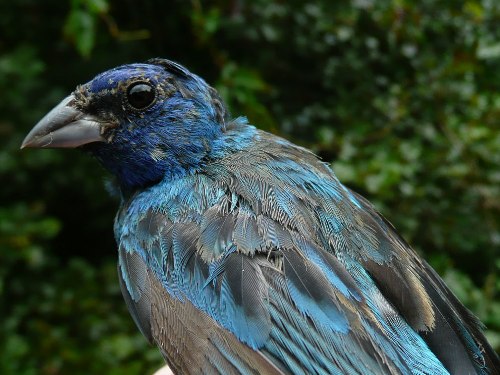 In the early part of our Fall Migration Monitoring Program, many of MBO’s local breeders (and some migrants from farther north) are undergoing their annual moult, and like this second-year male Indigo Bunting, are looking quite a bit scruffier than usual. (Photo by Gay Gruner) –
In the early part of our Fall Migration Monitoring Program, many of MBO’s local breeders (and some migrants from farther north) are undergoing their annual moult, and like this second-year male Indigo Bunting, are looking quite a bit scruffier than usual. (Photo by Gay Gruner) –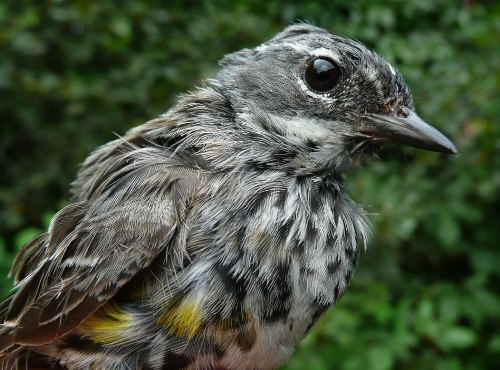 Another moulting adult banded during the first week of the season was this Yellow-rumped Warbler – more of a surprise as the species does not breed at MBO (Photo by Gay Gruner)
Another moulting adult banded during the first week of the season was this Yellow-rumped Warbler – more of a surprise as the species does not breed at MBO (Photo by Gay Gruner)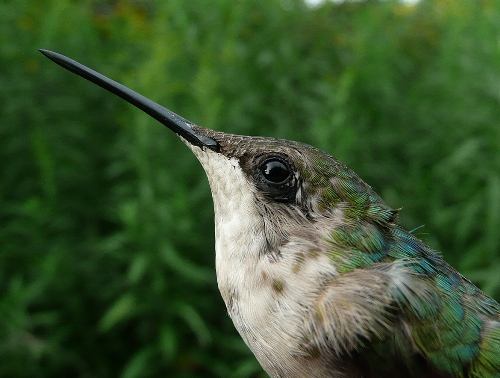 Ruby-throated Hummingbirds are one of the August specialties at MBO. Although we do not have the specialized permits or equipment to band them, we still catch some, and try to at least note their age and sex for our records. (Photo by Gay Gruner)
Ruby-throated Hummingbirds are one of the August specialties at MBO. Although we do not have the specialized permits or equipment to band them, we still catch some, and try to at least note their age and sex for our records. (Photo by Gay Gruner)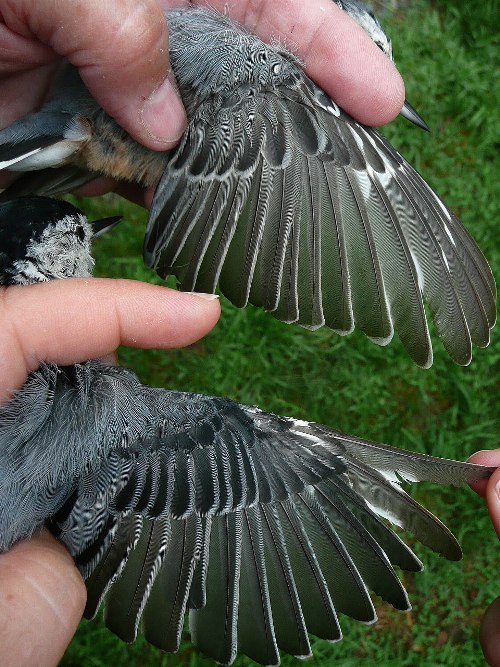 Although permanent residents at MBO, White-breasted Nuthatches are awfully good at avoiding the nets, with on average less than one banded each year. In fact, never before have we banded more than one in an entire season, so catching two at the same time was quite a surprise! Above, a hatch-year female; below, a second-year male (very likely her father), completing his prebasic moult. (Photo by Gay Gruner)
Although permanent residents at MBO, White-breasted Nuthatches are awfully good at avoiding the nets, with on average less than one banded each year. In fact, never before have we banded more than one in an entire season, so catching two at the same time was quite a surprise! Above, a hatch-year female; below, a second-year male (very likely her father), completing his prebasic moult. (Photo by Gay Gruner)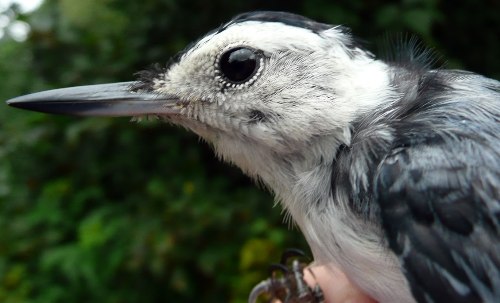 Profiles of the male (above) and female (below), showing the difference in plumage between the sexes. (Photos by Gay Gruner)
Profiles of the male (above) and female (below), showing the difference in plumage between the sexes. (Photos by Gay Gruner)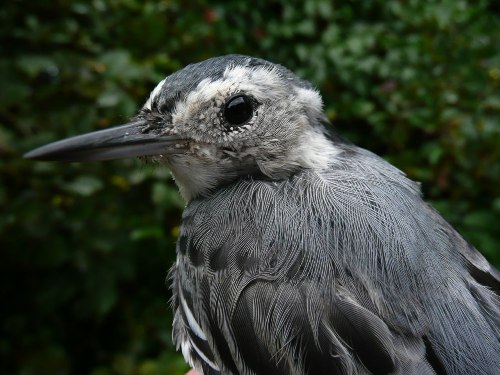
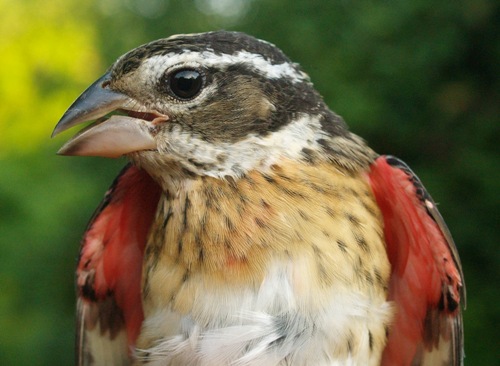 Rose-breasted Grosbeaks are one of MBO’s August specialties; here we have a hatch-year male giving away his identity through his underwing linings (Photo by Simon Duval)
Rose-breasted Grosbeaks are one of MBO’s August specialties; here we have a hatch-year male giving away his identity through his underwing linings (Photo by Simon Duval)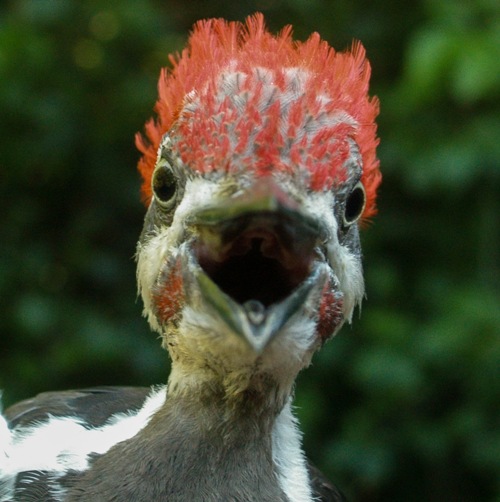 Always a rare treat, this Pileated Woodpecker was just the third of its kind banded during the Fall Migration Monitoring Program at MBO. (Photo by Simon Duval)
Always a rare treat, this Pileated Woodpecker was just the third of its kind banded during the Fall Migration Monitoring Program at MBO. (Photo by Simon Duval)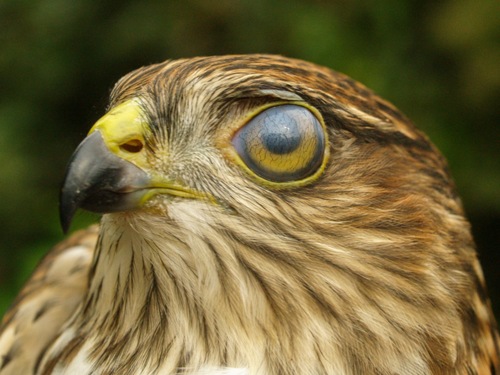 Here’s the first Sharp-shinned Hawk banded this fall – note that the protective nictitating membrane is completely covering the eye in this shot. (Photo by Simon Duval)
Here’s the first Sharp-shinned Hawk banded this fall – note that the protective nictitating membrane is completely covering the eye in this shot. (Photo by Simon Duval)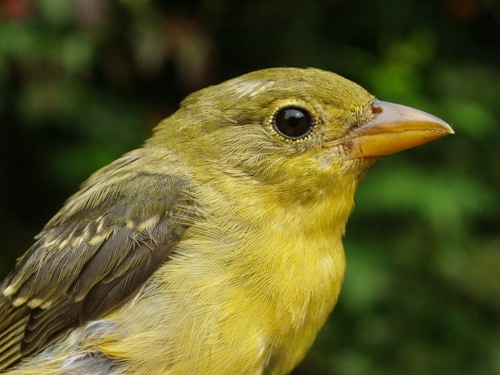 For the past two years, we’ve banded just a single Scarlet Tanager each fall – will this hatch-year female be the only one of 2012? (Photo by Simon Duval)
For the past two years, we’ve banded just a single Scarlet Tanager each fall – will this hatch-year female be the only one of 2012? (Photo by Simon Duval)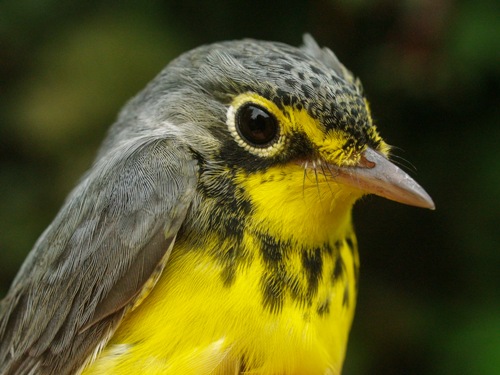 Another August specialty, and one of our favourites – Canada Warbler. (Photos by Simon Duval)
Another August specialty, and one of our favourites – Canada Warbler. (Photos by Simon Duval)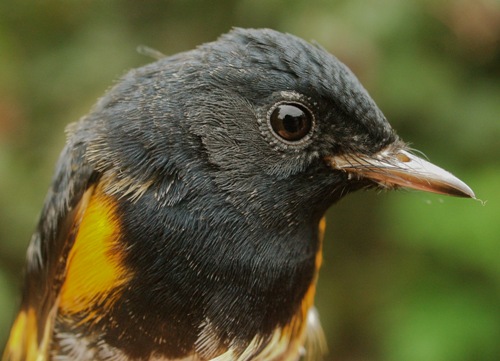 American Redstarts are migrating through MBO in good numbers again, with 81 banded already this fall, trailing only Song Sparrows in abundance. (Photo by Simon Duval)
American Redstarts are migrating through MBO in good numbers again, with 81 banded already this fall, trailing only Song Sparrows in abundance. (Photo by Simon Duval)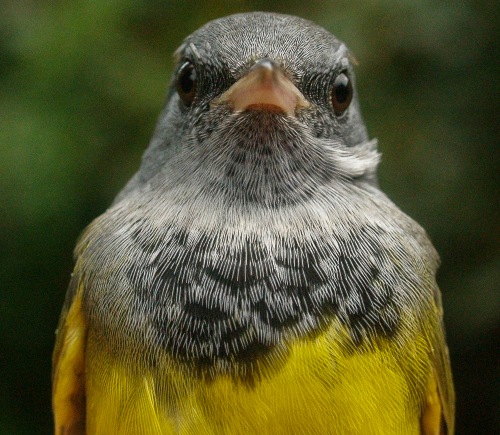 Mourning Warblers are one of the less common warblers at MBO, with a range of only 6-14 banded per fall season. (Photo by Simon Duval)
Mourning Warblers are one of the less common warblers at MBO, with a range of only 6-14 banded per fall season. (Photo by Simon Duval)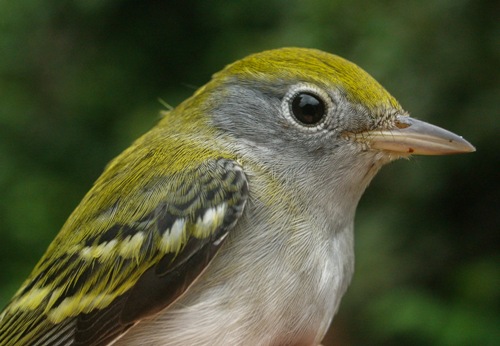 Although lacking its namesake streaks, this Chestnut-sided Warbler is still reasily recognizable in fall thanks to its greenish cap and plain gray face and underparts. (Photo by Simon Duval)
Although lacking its namesake streaks, this Chestnut-sided Warbler is still reasily recognizable in fall thanks to its greenish cap and plain gray face and underparts. (Photo by Simon Duval)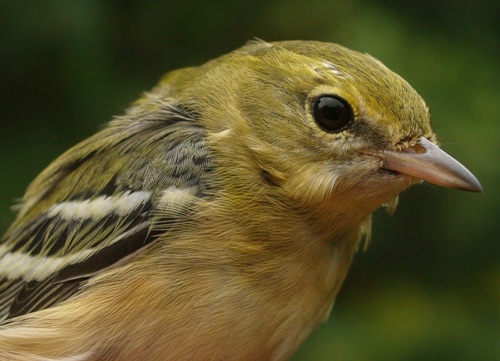 This is the time of year that the infamous “confusing fall warblers” start causing headaches for birders. In the hand there are some extra clues available, but even just a good view of these species is actually usually enough to identify them correctly. Above is a Bay-breasted Warbler, very different from how it looks during the breeding season, but recognizable in fall by its warm buffy underparts and greenish head, without much streaking. (Photo by Simon Duval)
This is the time of year that the infamous “confusing fall warblers” start causing headaches for birders. In the hand there are some extra clues available, but even just a good view of these species is actually usually enough to identify them correctly. Above is a Bay-breasted Warbler, very different from how it looks during the breeding season, but recognizable in fall by its warm buffy underparts and greenish head, without much streaking. (Photo by Simon Duval)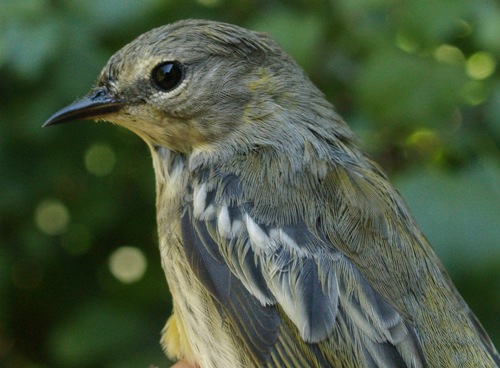 For comparison, here is a Cape May Warbler, more of a grayish-green overall, and with distinct streaking on the breast. (Photo by Simon Duval)
For comparison, here is a Cape May Warbler, more of a grayish-green overall, and with distinct streaking on the breast. (Photo by Simon Duval)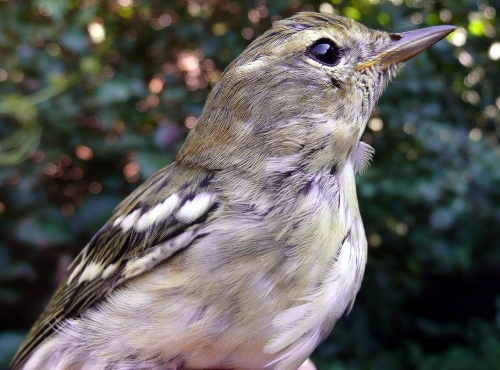 And to complete this trio, a Blackpoll Warbler, the palest of these species, but with the strongest facial pattern. (Photos by Simon Duval)
And to complete this trio, a Blackpoll Warbler, the palest of these species, but with the strongest facial pattern. (Photos by Simon Duval)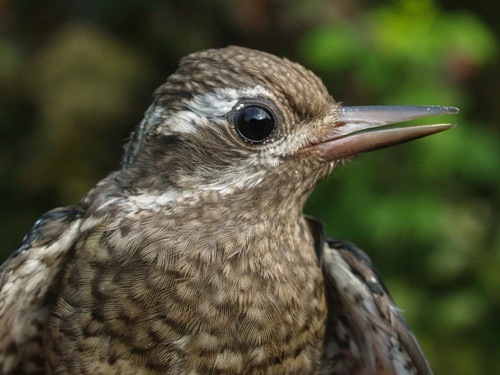 Puzzled what this is? Many field guides aren’t great at illustrating juvenile birds. This is a young Yellow-bellied Sapsucker, our first of the fall. (Photo by Simon Duval)
Puzzled what this is? Many field guides aren’t great at illustrating juvenile birds. This is a young Yellow-bellied Sapsucker, our first of the fall. (Photo by Simon Duval)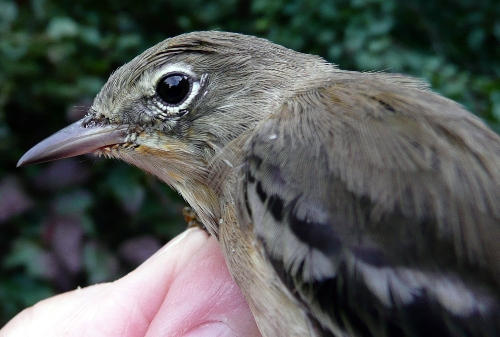 This is a good complement to last week’s “confusing fall warbler” photo series. It is only the second Pine Warbler ever banded at MBO, recognizable by its drab plumage (aside from prominent wing bars) and stout bill. (Photo by Gay Gruner)
This is a good complement to last week’s “confusing fall warbler” photo series. It is only the second Pine Warbler ever banded at MBO, recognizable by its drab plumage (aside from prominent wing bars) and stout bill. (Photo by Gay Gruner)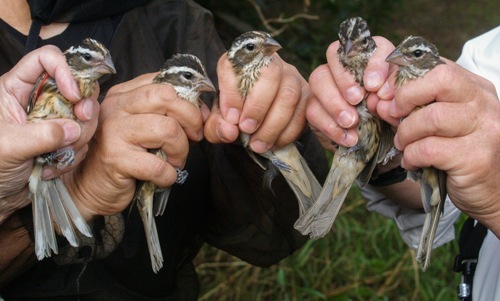 Rose-breasted Grosbeak numbers were at a record low at MBO last fall, so this week’s 15 banded, including these five at the same time, are an encouraging sign that numbers are returning to normal. (Photo by Simon Duval)
Rose-breasted Grosbeak numbers were at a record low at MBO last fall, so this week’s 15 banded, including these five at the same time, are an encouraging sign that numbers are returning to normal. (Photo by Simon Duval)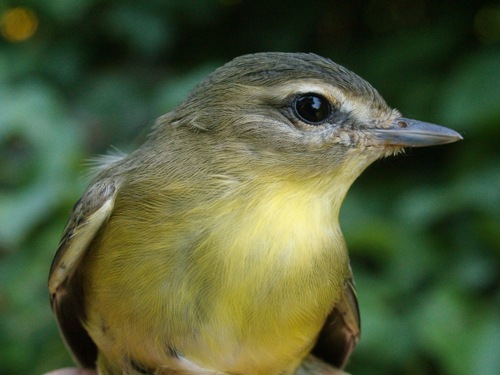 Philadelphia Vireo is primarily a September migrant at MBO, but the first one of the year came through this week. (Photo by Simon Duval)
Philadelphia Vireo is primarily a September migrant at MBO, but the first one of the year came through this week. (Photo by Simon Duval)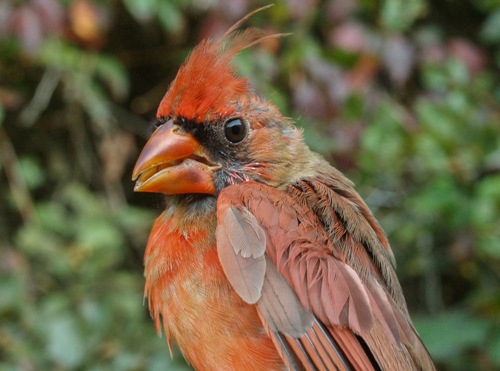 Although it is only late August, this hatch-year Northern Cardinal is already largely red. (Photo by Simon Duval)
Although it is only late August, this hatch-year Northern Cardinal is already largely red. (Photo by Simon Duval)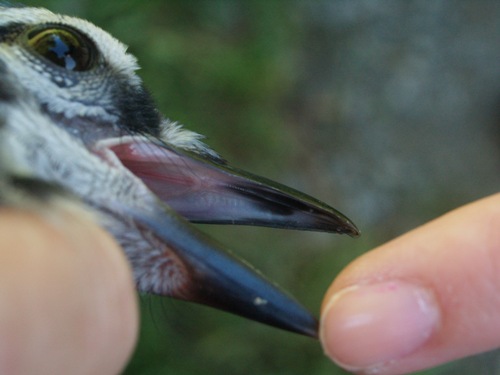 Among the research projects underway at MBO this fall is documentation of the upper mouth lining of jays and vireos to determine the reliability of this feature for ageing. This hatch-year Blue Jay already has a fair amount of black in the lining (in adults it is expected to be mostly to entirely black). (Photos by Simon Duval)
Among the research projects underway at MBO this fall is documentation of the upper mouth lining of jays and vireos to determine the reliability of this feature for ageing. This hatch-year Blue Jay already has a fair amount of black in the lining (in adults it is expected to be mostly to entirely black). (Photos by Simon Duval)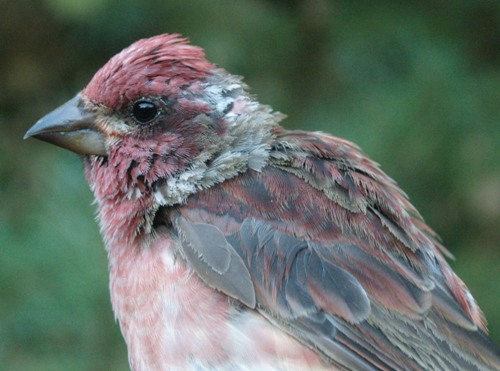 Purple Finches were the big surprise this week, with 9 individuals banded including this second-year male part way through its prebasic molt. (Photo by Simon Duval)
Purple Finches were the big surprise this week, with 9 individuals banded including this second-year male part way through its prebasic molt. (Photo by Simon Duval)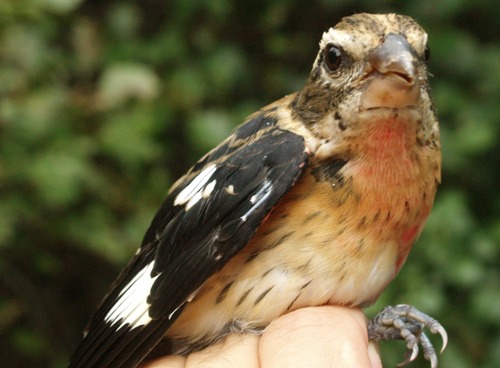 Continuing the molt theme, this week’s birds included an after-second-year Rose-breasted Grosbeak above (looking quite different from its summer plumage already, but with all-dark primaries and secondaries), and the hatch-year Northern Cardinal below, just starting to get its red crest. (Photos by Simon Duval)
Continuing the molt theme, this week’s birds included an after-second-year Rose-breasted Grosbeak above (looking quite different from its summer plumage already, but with all-dark primaries and secondaries), and the hatch-year Northern Cardinal below, just starting to get its red crest. (Photos by Simon Duval)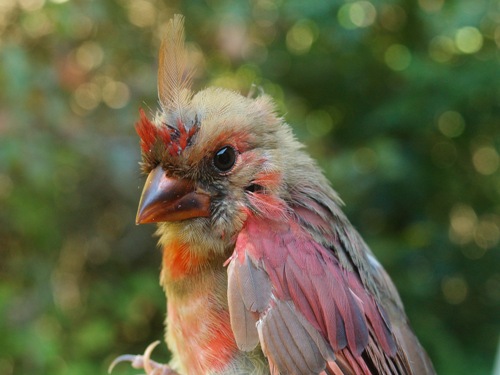
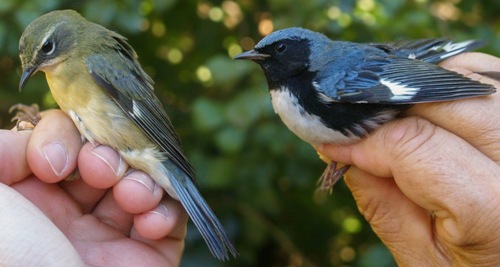 One of the few warbler species in which the sexes are easily separable in fall, Black-throated Blue Warbler. (Photo by Simon Duval)
One of the few warbler species in which the sexes are easily separable in fall, Black-throated Blue Warbler. (Photo by Simon Duval)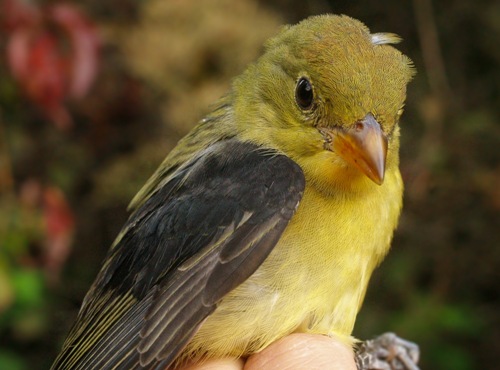 Rounding out this week’s photos illustrating molt, the hatch-year Scarlet Tanager above shows a distinct limit on the wing between its brown juvenile feathers and replaced blackish preformative feathers, while the female Indigo Bunting below is in the midst of its prebasic molt, with some of its old and worn primaries and secondaries contrasting with the darker new basic feathers. (Photos by Simon Duval)
Rounding out this week’s photos illustrating molt, the hatch-year Scarlet Tanager above shows a distinct limit on the wing between its brown juvenile feathers and replaced blackish preformative feathers, while the female Indigo Bunting below is in the midst of its prebasic molt, with some of its old and worn primaries and secondaries contrasting with the darker new basic feathers. (Photos by Simon Duval)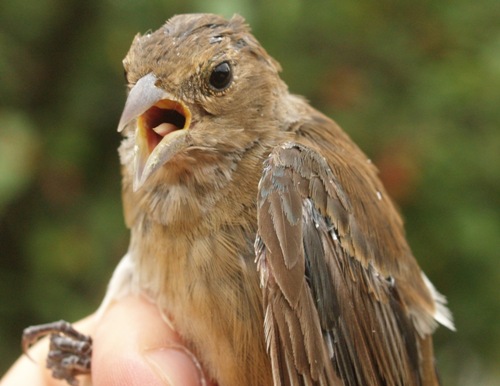
 Although the long run of dry weather has been great for operating our daily program, it has taken a toll on our ponds – this is about as dry as we’ve ever seen the back pond at this time of year, and we have to hope there will be some replenishment eventually. (Photo by Gay Gruner)
Although the long run of dry weather has been great for operating our daily program, it has taken a toll on our ponds – this is about as dry as we’ve ever seen the back pond at this time of year, and we have to hope there will be some replenishment eventually. (Photo by Gay Gruner)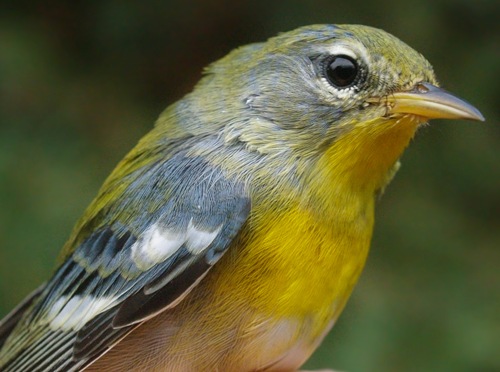 MBO’s first Northern Parula of the 2012 fall season (Photo by Simon Duval)
MBO’s first Northern Parula of the 2012 fall season (Photo by Simon Duval)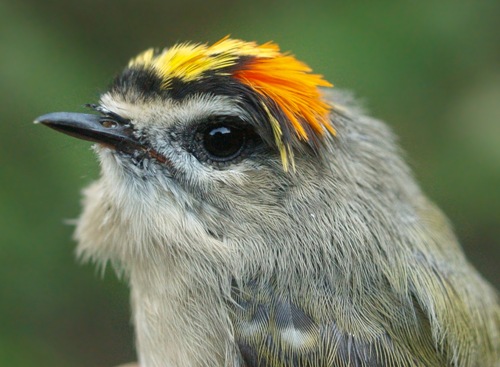 Some unusually early arrivals this week included the male Golden-crowned Kinglet above, and adult female Slate-colored Junco below. (Photos by Simon Duval)
Some unusually early arrivals this week included the male Golden-crowned Kinglet above, and adult female Slate-colored Junco below. (Photos by Simon Duval)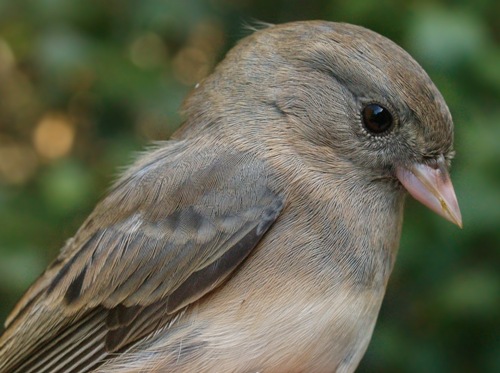
 A young birder takes in the banding demonstration at our first Sponsor’s Day on Sunday September 9. The day was held to thank generous sponsors who have donated to MBO through the Baillie Birdathon or other financial or in-kind contributions, and to show them what we do on a daily basis at MBO. Over 40 visitors attended, who had the opportunity to watch Simon band, accompany a censuser, visit the nets, and learn more about our research and education objectives.
A young birder takes in the banding demonstration at our first Sponsor’s Day on Sunday September 9. The day was held to thank generous sponsors who have donated to MBO through the Baillie Birdathon or other financial or in-kind contributions, and to show them what we do on a daily basis at MBO. Over 40 visitors attended, who had the opportunity to watch Simon band, accompany a censuser, visit the nets, and learn more about our research and education objectives.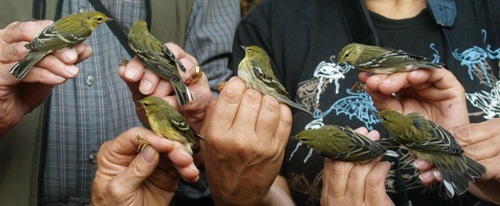 Part of our influx of Blackpoll Warblers. (Photo by Simon Duval)
Part of our influx of Blackpoll Warblers. (Photo by Simon Duval)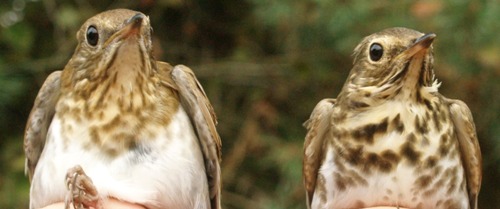 A nice comparative portrait of two thrushes present at MBO in record numbers this fall: Veery on the left, and Swainson’s Thrush on the right. (Photo by Simon Duval)
A nice comparative portrait of two thrushes present at MBO in record numbers this fall: Veery on the left, and Swainson’s Thrush on the right. (Photo by Simon Duval)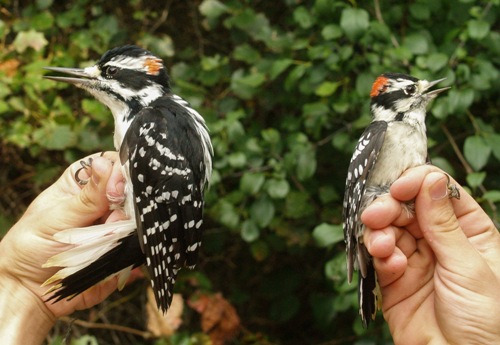 Another good comparison, showing the difference in size (and for that matter plumage on the head and tail) between Hairy Woodpecker on the left and Downy Woodpecker on the right. (Photo by Simon Duval)
Another good comparison, showing the difference in size (and for that matter plumage on the head and tail) between Hairy Woodpecker on the left and Downy Woodpecker on the right. (Photo by Simon Duval)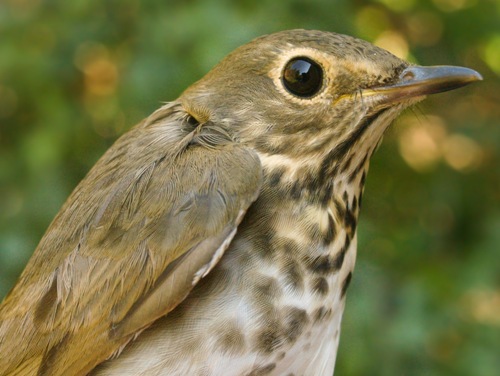 Where are all the Swainson’s Thrushes coming from? This week alone we banded nearly twice as many of them as in any of our previous 7 full fall seasons! (Photo by Simon Duval)
Where are all the Swainson’s Thrushes coming from? This week alone we banded nearly twice as many of them as in any of our previous 7 full fall seasons! (Photo by Simon Duval)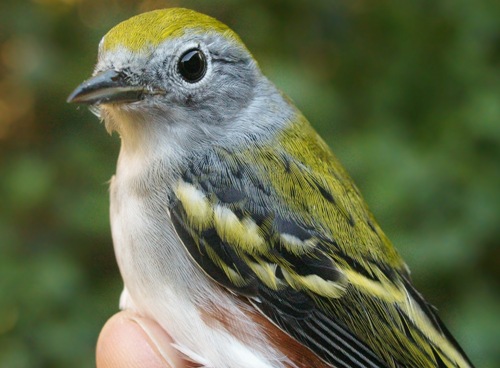 A couple of MBO’s less abundant warblers – Chestnut-sided Warbler (above) with 23 banded to this point in the season, and Bay-breasted Warbler (below), with just 5 individuals to date. (Photos by Simon Duval)
A couple of MBO’s less abundant warblers – Chestnut-sided Warbler (above) with 23 banded to this point in the season, and Bay-breasted Warbler (below), with just 5 individuals to date. (Photos by Simon Duval)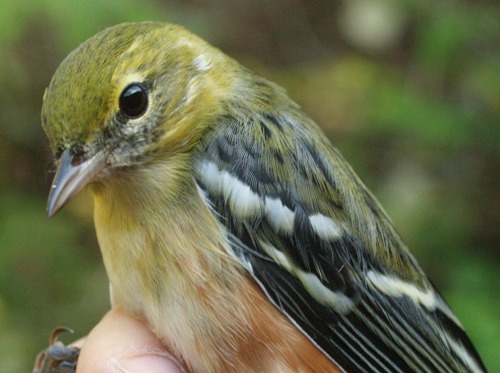
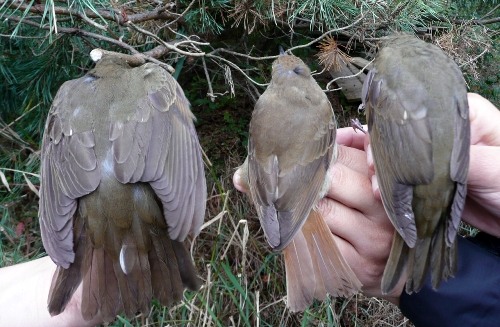 Although Swainson’s Thrushes dominated the week, we also had some of their close relatives pay a visit. Can you recognize these three species from this angle? Answers at the end of this week’s report. (Photo by Gay Gruner)
Although Swainson’s Thrushes dominated the week, we also had some of their close relatives pay a visit. Can you recognize these three species from this angle? Answers at the end of this week’s report. (Photo by Gay Gruner)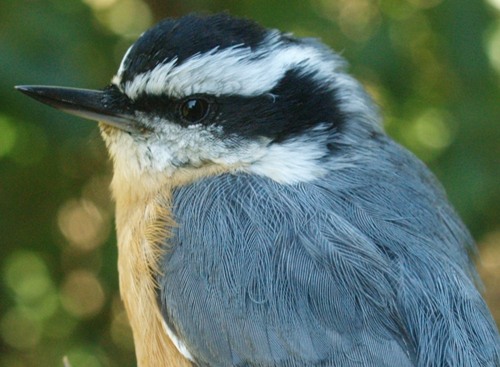 Although large flocks of Red-breasted Nuthatches have been swarming parts of southern Ontario already this fall, the invasion has so far been a bit more modest at MBO. While above average numbers have been seen, this male banded this week was the first one caught this fall. (Photo by Simon Duval)
Although large flocks of Red-breasted Nuthatches have been swarming parts of southern Ontario already this fall, the invasion has so far been a bit more modest at MBO. While above average numbers have been seen, this male banded this week was the first one caught this fall. (Photo by Simon Duval)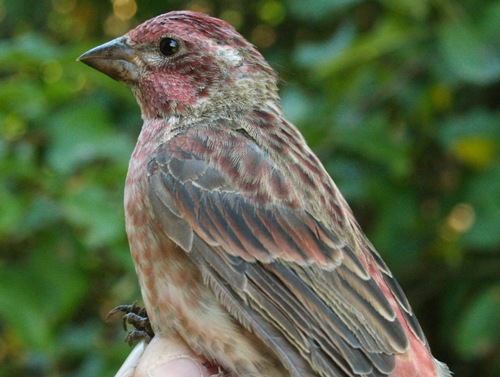 Seemingly moving in tandem with the Red-breasted Nuthatches are Purple Finches, although we have been banding more of them – 25 as of the end of this week, shattering the previous season record of 11. This second-year male can be easily aged by the stark contrast between his faded brown outer primaries and inner secondaries, compared to the replaced feathers in between. (Photo by Simon Duval)
Seemingly moving in tandem with the Red-breasted Nuthatches are Purple Finches, although we have been banding more of them – 25 as of the end of this week, shattering the previous season record of 11. This second-year male can be easily aged by the stark contrast between his faded brown outer primaries and inner secondaries, compared to the replaced feathers in between. (Photo by Simon Duval)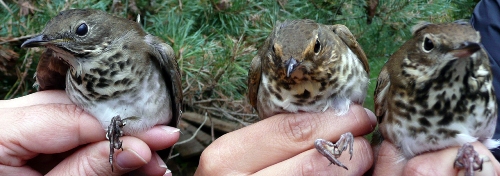 Here is a front view of the three thrushes – but did you notice that two of them have switched position compared to the previous photo? On the left in both photos is a Gray-cheeked Thrush; in the middle here and on the right in the previous photo is one of our many Swainson’s Thrushes; on the right here and in the middle previously is the first Hermit Thrush of the season. (Photo by Gay Gruner)
Here is a front view of the three thrushes – but did you notice that two of them have switched position compared to the previous photo? On the left in both photos is a Gray-cheeked Thrush; in the middle here and on the right in the previous photo is one of our many Swainson’s Thrushes; on the right here and in the middle previously is the first Hermit Thrush of the season. (Photo by Gay Gruner)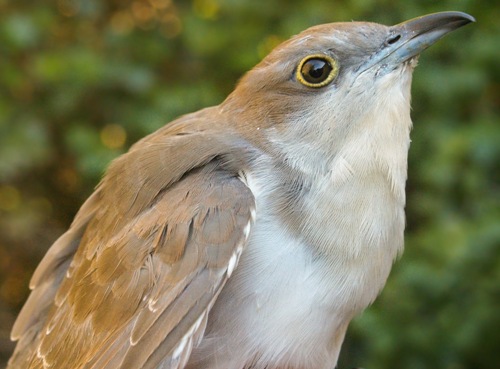 The highlight of the week was this hatch-year Black-billed Cuckoo, only the seventh banded at MBO in 8 years, and the first since spring 2011. It was also the latest ever fall record of the species at MBO. (Photo by Simon Duval)
The highlight of the week was this hatch-year Black-billed Cuckoo, only the seventh banded at MBO in 8 years, and the first since spring 2011. It was also the latest ever fall record of the species at MBO. (Photo by Simon Duval)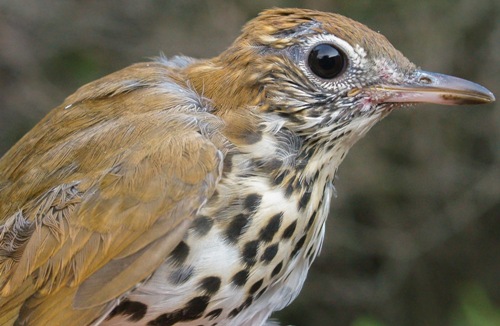 Actually an even greater rarity at MBO than the Black-billed Cuckoo, the Wood Thrush above was only the sixth of its kind banded in MBO’s history, but the second this year. Brown Creepers are only moderately more common, with this week’s five (including the one below) bringing the cumulative total to 80 individuals. (Photos by Simon Duval)
Actually an even greater rarity at MBO than the Black-billed Cuckoo, the Wood Thrush above was only the sixth of its kind banded in MBO’s history, but the second this year. Brown Creepers are only moderately more common, with this week’s five (including the one below) bringing the cumulative total to 80 individuals. (Photos by Simon Duval)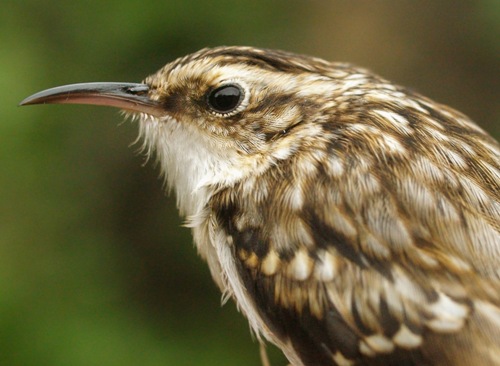
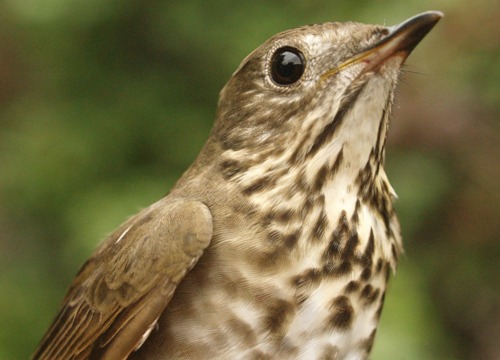 One of a record-setting ten Gray-cheeked Thrushes banded at MBO this week. (Photo by Simon Duval)
One of a record-setting ten Gray-cheeked Thrushes banded at MBO this week. (Photo by Simon Duval)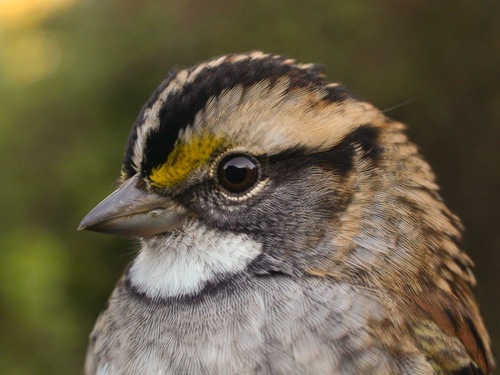 The dominant songbird of the week, White-throated Sparrow. (Photo by Simon Duval)
The dominant songbird of the week, White-throated Sparrow. (Photo by Simon Duval)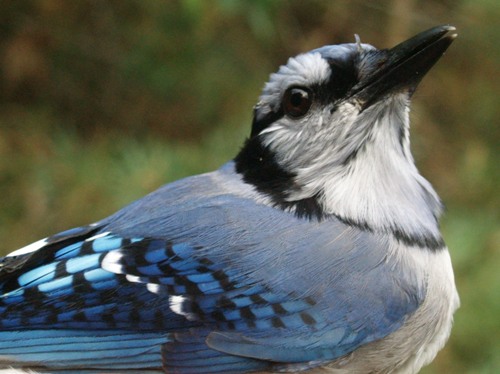 We have never before banded as many Blue Jays in a week – this was one of the 24 that we banded over the course of week 8. (Photo by Simon Duval)
We have never before banded as many Blue Jays in a week – this was one of the 24 that we banded over the course of week 8. (Photo by Simon Duval)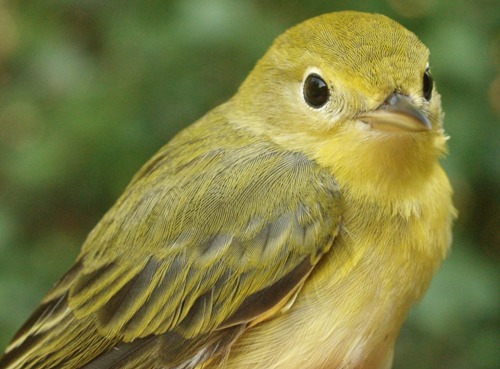 An exceptionally late Yellow Warbler – only the second one we have ever banded this far into the fall season. (Photo by Simon Duval)
An exceptionally late Yellow Warbler – only the second one we have ever banded this far into the fall season. (Photo by Simon Duval)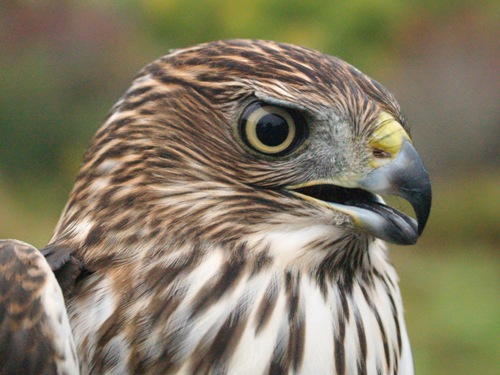 Week 9 began impressively with this female Cooper’s Hawk, just the third of its kind banded at MBO. (Photo by Simon Duval)
Week 9 began impressively with this female Cooper’s Hawk, just the third of its kind banded at MBO. (Photo by Simon Duval) These two Orange-crowned Warblers provide an interesting contrast, and fodder for debate. Are they simply two extremes of plumage of the eastern celata subspecies, or is the one on the left an orestera subspecies from western Canada? (Photo by Simon Duval)
These two Orange-crowned Warblers provide an interesting contrast, and fodder for debate. Are they simply two extremes of plumage of the eastern celata subspecies, or is the one on the left an orestera subspecies from western Canada? (Photo by Simon Duval)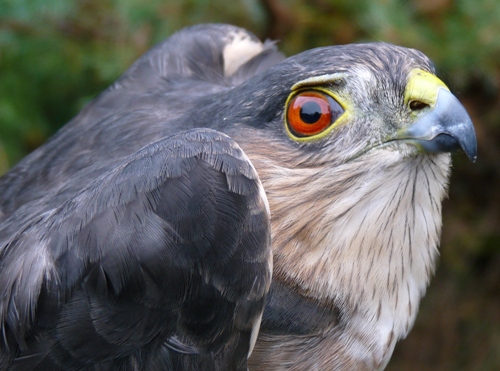 Although Sharp-shinned Hawks are banded at MBO far more often than any other raptor, the vast majority of them are hatch-year birds, so this after-second-year female with prominent reddish eyes was a rare treat to see up close. (Photo by Marcel Gahbauer)
Although Sharp-shinned Hawks are banded at MBO far more often than any other raptor, the vast majority of them are hatch-year birds, so this after-second-year female with prominent reddish eyes was a rare treat to see up close. (Photo by Marcel Gahbauer)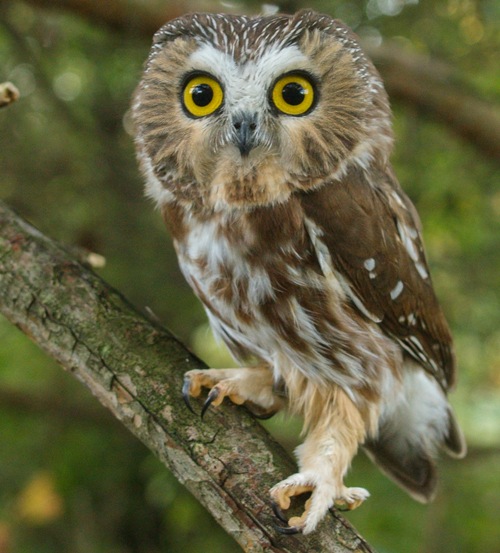 The Saw-whet Owl Monitoring Program is up and running again – but this one decided to be part of our overall Fall Migration Monitoring Program instead, showing up in the first net round of the morning on Thursday. (Photo by Simon Duval)
The Saw-whet Owl Monitoring Program is up and running again – but this one decided to be part of our overall Fall Migration Monitoring Program instead, showing up in the first net round of the morning on Thursday. (Photo by Simon Duval)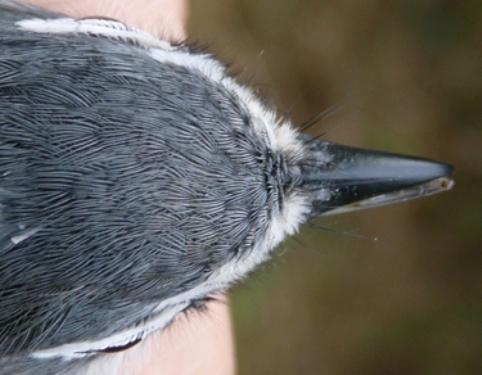 Nearly one year ago (
Nearly one year ago (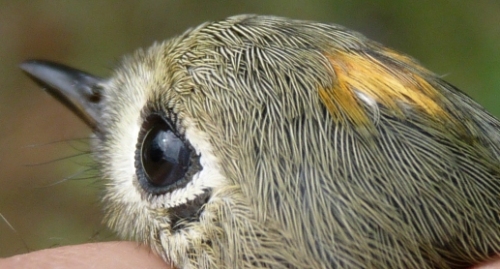
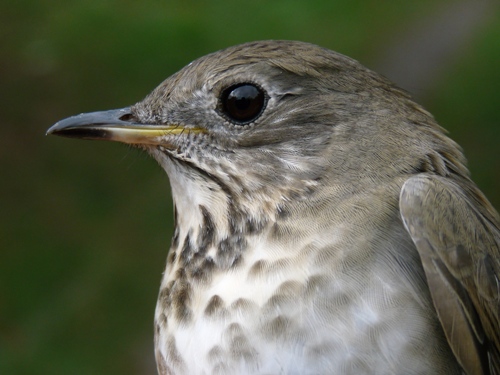 Remarkably, after banding only three Bicknell’s Thrushes over our first seven years, we had two this week, including the one above. (Photo by Marcel Gahbauer)
Remarkably, after banding only three Bicknell’s Thrushes over our first seven years, we had two this week, including the one above. (Photo by Marcel Gahbauer)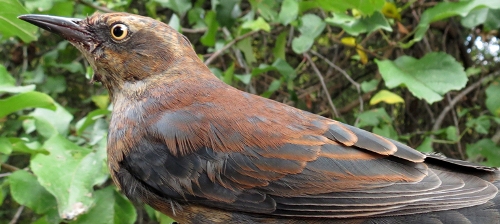 The Bicknell’s Thrush (listed under the Species at Risk Act as Threatened) wasn’t the only species at risk banded this week – we also had this Rusty Blackbird, classified as Special Concern. (Photo by Gay Gruner)
The Bicknell’s Thrush (listed under the Species at Risk Act as Threatened) wasn’t the only species at risk banded this week – we also had this Rusty Blackbird, classified as Special Concern. (Photo by Gay Gruner)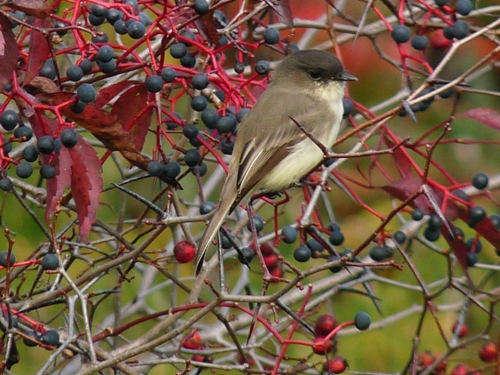 Not as rare with respec to status, but also getting distinctly uncommon by this point in fall are all the flycatchers, with an occasional Eastern Phoebe such as this the only species we are likely to encounter – in this case finding a perch among one of our hawthorns, liberally decorated with Virginia Creeper. (Photo by Marcel Gahbauer)
Not as rare with respec to status, but also getting distinctly uncommon by this point in fall are all the flycatchers, with an occasional Eastern Phoebe such as this the only species we are likely to encounter – in this case finding a perch among one of our hawthorns, liberally decorated with Virginia Creeper. (Photo by Marcel Gahbauer)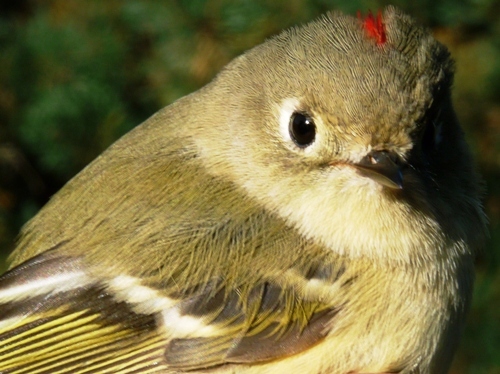 In a week as busy as this, there were many highlights, but the bird of the week was this after-hatch-year male Ruby-crowned Kinglet, for the simple reason that on Sunday morning it became the 40,000th bird banded at MBO since our start in 200(Photo by Marcel Gahbauer) –
In a week as busy as this, there were many highlights, but the bird of the week was this after-hatch-year male Ruby-crowned Kinglet, for the simple reason that on Sunday morning it became the 40,000th bird banded at MBO since our start in 200(Photo by Marcel Gahbauer) –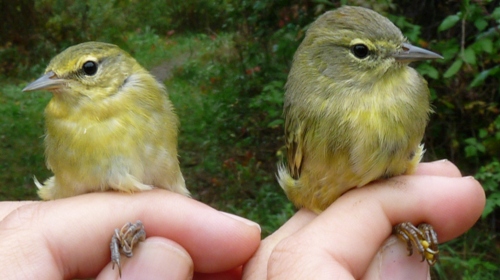 For the second week in a row, we have a comparison of two greenish-gray warblers in this space. This time though, the one on the left is a Tennessee Warbler (with a stronger facial pattern), and the one on the right is an Orange-crowned Warbler (with a trace of streaking on the breast). Below is another particularly yellow Orange-crowned Warbler we banded this week, looking much like the western orestera subspecies. (Photos by Marcel Gahbauer)
For the second week in a row, we have a comparison of two greenish-gray warblers in this space. This time though, the one on the left is a Tennessee Warbler (with a stronger facial pattern), and the one on the right is an Orange-crowned Warbler (with a trace of streaking on the breast). Below is another particularly yellow Orange-crowned Warbler we banded this week, looking much like the western orestera subspecies. (Photos by Marcel Gahbauer)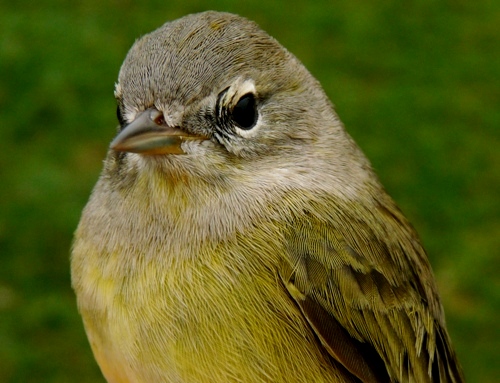
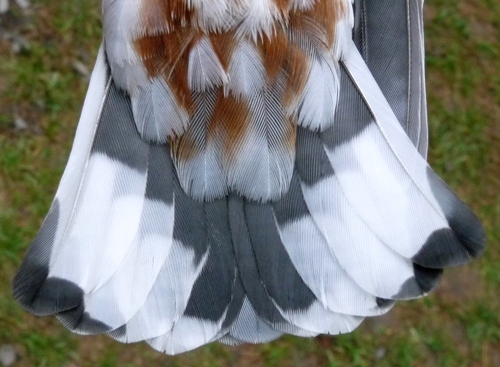 Quiz – to what species does this undertail belong? (Photo by Marcel Gahbauer)
Quiz – to what species does this undertail belong? (Photo by Marcel Gahbauer)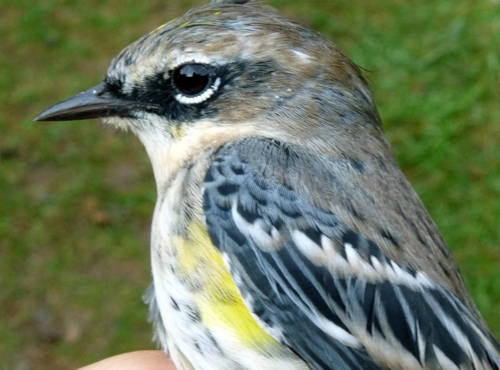 Among the many Yellow-rumped Warblers banded this week were the after-hatch-year male above with an unusually dark face, as well as the after-hatch-year female below in an unusually early stage of moult, with four secondaries still retained, and the outer primaries not yet fully replaced. (Photos by Marcel Gahbauer)
Among the many Yellow-rumped Warblers banded this week were the after-hatch-year male above with an unusually dark face, as well as the after-hatch-year female below in an unusually early stage of moult, with four secondaries still retained, and the outer primaries not yet fully replaced. (Photos by Marcel Gahbauer)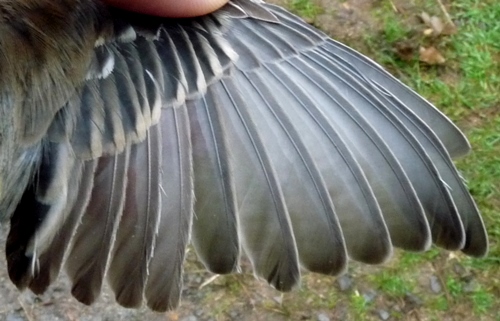
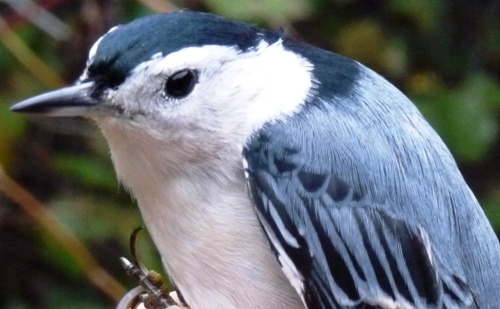 Quiz answer – the undertail belongs to this White-breasted Nuthatch, just the tenth of its kind banded at MBO (but the fourth this fall). Meanwhile, below is another Ruby-crowned Kinglet with aberrant plumage –
Quiz answer – the undertail belongs to this White-breasted Nuthatch, just the tenth of its kind banded at MBO (but the fourth this fall). Meanwhile, below is another Ruby-crowned Kinglet with aberrant plumage – 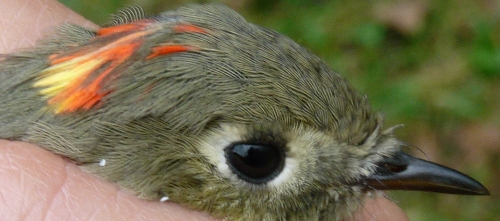
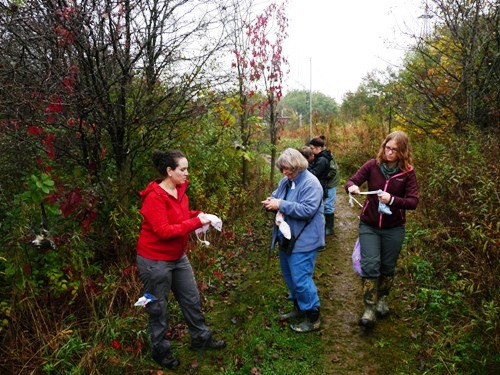 We always appreciate the contributions of all our volunteers, but the value of an experienced and diverse team is all the more apparent at the peak of migration. Especially given that this week also included Thanksgiving, we would like to take this opportunity to extend our appreciation to everyone who has helped at MBO this year in any capacity. Above, part of our Thursday morning crew efficiently working their way through clearing a busy net H1. (Photo by Marcel Gahbauer)
We always appreciate the contributions of all our volunteers, but the value of an experienced and diverse team is all the more apparent at the peak of migration. Especially given that this week also included Thanksgiving, we would like to take this opportunity to extend our appreciation to everyone who has helped at MBO this year in any capacity. Above, part of our Thursday morning crew efficiently working their way through clearing a busy net H1. (Photo by Marcel Gahbauer) Meanwhile on the same day, “Team Duval” (bander Simon and scribe Réjean, no relation) were busy inside keeping up with all the birds being brought in from the nets. (Photo by Marcel Gahbauer)
Meanwhile on the same day, “Team Duval” (bander Simon and scribe Réjean, no relation) were busy inside keeping up with all the birds being brought in from the nets. (Photo by Marcel Gahbauer) One of the reasons for MBO’s success is our focus on training and welcoming banders from elsewhere, which helps ensure that we have the capacity to handle peak periods safely. On one of this week’s busier days, the bander-in-charge was able to take a breather, knowing that James Junda (our bander from fall 2008, now back in Montreal to pursue his M.Sc.) and Marie-Pier Laplante (one of our banders-in-training) could efficiently process the birds, with Alison Hackney ably juggling data entry for both. (Photo by Marcel Gahbauer)
One of the reasons for MBO’s success is our focus on training and welcoming banders from elsewhere, which helps ensure that we have the capacity to handle peak periods safely. On one of this week’s busier days, the bander-in-charge was able to take a breather, knowing that James Junda (our bander from fall 2008, now back in Montreal to pursue his M.Sc.) and Marie-Pier Laplante (one of our banders-in-training) could efficiently process the birds, with Alison Hackney ably juggling data entry for both. (Photo by Marcel Gahbauer)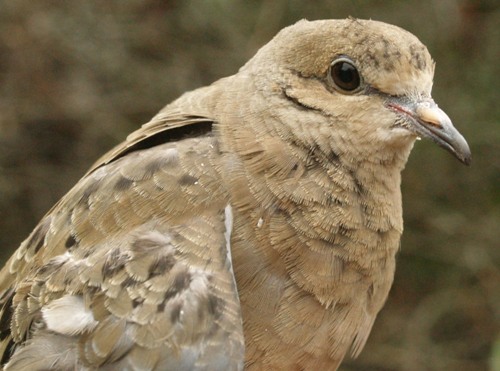 Although we see Mourning Doves almost daily in fall, and have over the years banded 43 of them in winter and one in spring, the one above was the first one ever banded as part of the Fall Migration Monitoring Program. (Photo by Simon Duval)
Although we see Mourning Doves almost daily in fall, and have over the years banded 43 of them in winter and one in spring, the one above was the first one ever banded as part of the Fall Migration Monitoring Program. (Photo by Simon Duval)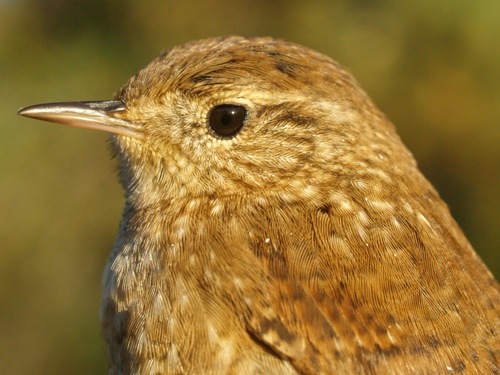 Only our third Winter Wren of the season, posing nicely in the morning light. (Photos by Simon Duval)
Only our third Winter Wren of the season, posing nicely in the morning light. (Photos by Simon Duval)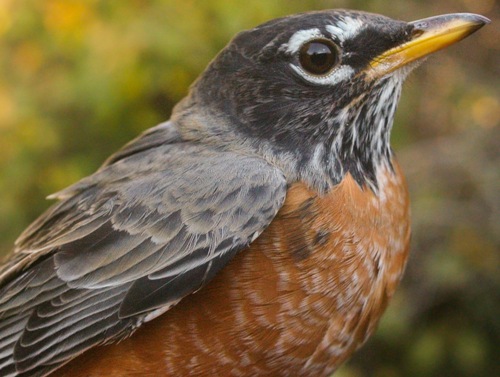 Robin season is upon us again! Many people see them as a sign of spring, but at MBO, they are never more common than in October. (Photo by Simon Duval)
Robin season is upon us again! Many people see them as a sign of spring, but at MBO, they are never more common than in October. (Photo by Simon Duval)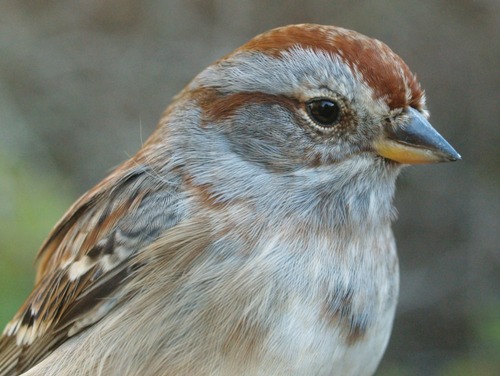 One of just two American Tree Sparrows banded so far this fall, but this is a species that almost always peaks in the final week of the Fall Migration Monitoring Program, so we are certain that more are on their way. (Photo by Simon Duval)
One of just two American Tree Sparrows banded so far this fall, but this is a species that almost always peaks in the final week of the Fall Migration Monitoring Program, so we are certain that more are on their way. (Photo by Simon Duval)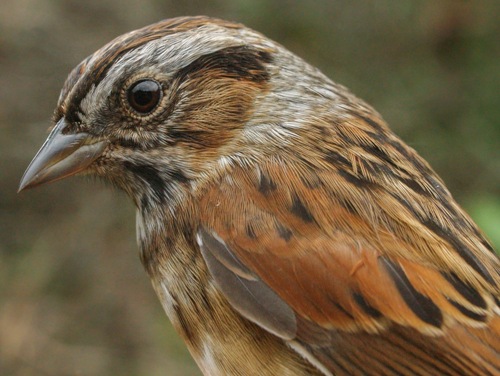 Among the many “brown birds” dominating the nets recently, Swamp Sparrows have not been abundant enough to draw a lot of attention, but 16 birds over the past two weeks is nonetheless a bit above average for this species, even though weeks 10 and 11 are their typical peak of migration. The photo below illustrates particularly well how elongated the bill is compared to most other sparrows. (Photo above by Simon Duval, below by Gay Gruner)
Among the many “brown birds” dominating the nets recently, Swamp Sparrows have not been abundant enough to draw a lot of attention, but 16 birds over the past two weeks is nonetheless a bit above average for this species, even though weeks 10 and 11 are their typical peak of migration. The photo below illustrates particularly well how elongated the bill is compared to most other sparrows. (Photo above by Simon Duval, below by Gay Gruner)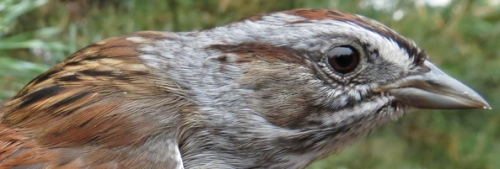
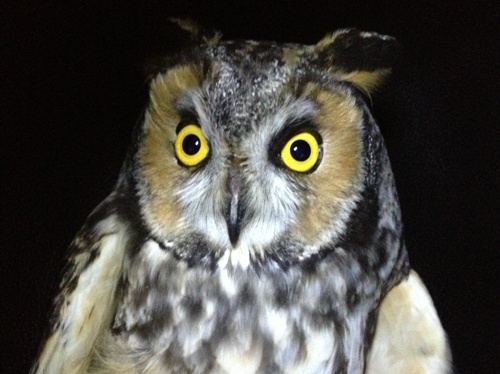 Generally we feature the owl highlights later in the weekly report. However, after hearing Long-eared Owls regularly throughout all our previous years of owling, this week we managed our first capture of one – and a couple of hours later banded a second one, making for a most memorable night! (Photo by Simon Duval)
Generally we feature the owl highlights later in the weekly report. However, after hearing Long-eared Owls regularly throughout all our previous years of owling, this week we managed our first capture of one – and a couple of hours later banded a second one, making for a most memorable night! (Photo by Simon Duval)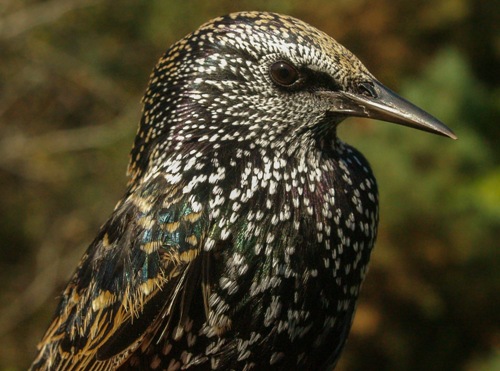 Had it not been for the surprises from our owling program, the European Starling above could well have been our bird of the week. As abundant as the species is overall, we band it only rarely at MBO – this was just our 12th overall, and our third as part of the Fall Migration Monitoring Program. Another good candidate would have been the Rusty Blackbird below, our 13th in 8 years of operation – though our second this fall, and amazingly, our sixth of the year … 2012 has been good for them here! (Photos by Simon Duval)
Had it not been for the surprises from our owling program, the European Starling above could well have been our bird of the week. As abundant as the species is overall, we band it only rarely at MBO – this was just our 12th overall, and our third as part of the Fall Migration Monitoring Program. Another good candidate would have been the Rusty Blackbird below, our 13th in 8 years of operation – though our second this fall, and amazingly, our sixth of the year … 2012 has been good for them here! (Photos by Simon Duval)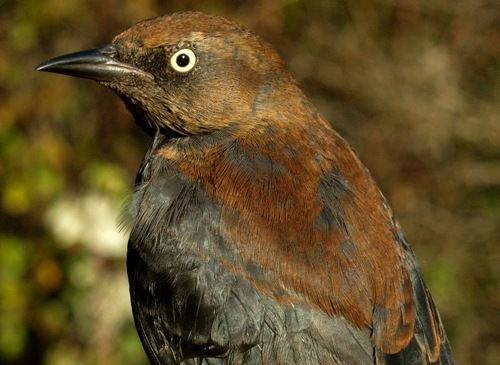
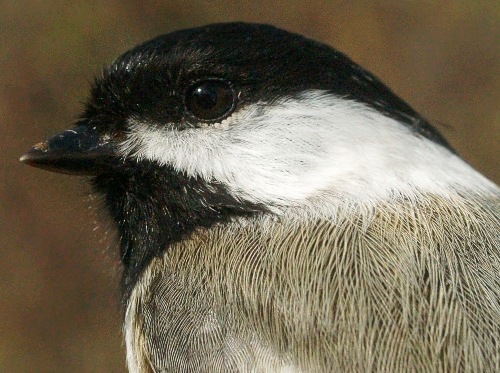 One of the 43 Black-capped Chickadees we banded on October 23 – the highest number of them we’ve ever had in a single day! (Photo by Simon Duval)
One of the 43 Black-capped Chickadees we banded on October 23 – the highest number of them we’ve ever had in a single day! (Photo by Simon Duval)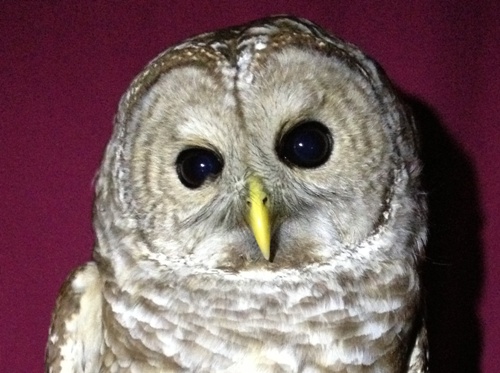 As if the Long-eared Owls weren’t a big enough surprise this week, we also banded this Barred Owl – more of a surprise, as we have only occasionally heard this species at MBO while out at night. (Photo by Simon Duval)
As if the Long-eared Owls weren’t a big enough surprise this week, we also banded this Barred Owl – more of a surprise, as we have only occasionally heard this species at MBO while out at night. (Photo by Simon Duval)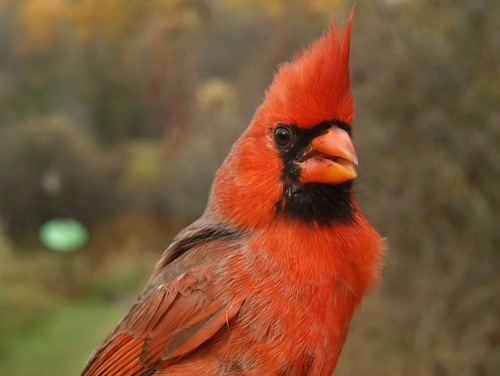 This week we recaptured the fully red male Northern Cardinal above. It’s only because we banded it back in August (below) that we know it is actually a hatch-year bird, since its preformative moult was complete, as is often the case for this species. This also happened to be our busiest week ever for Northern Cardinals, with 6 banded, bringing the season total to a record high of 16. (Photos by Simon Duval)
This week we recaptured the fully red male Northern Cardinal above. It’s only because we banded it back in August (below) that we know it is actually a hatch-year bird, since its preformative moult was complete, as is often the case for this species. This also happened to be our busiest week ever for Northern Cardinals, with 6 banded, bringing the season total to a record high of 16. (Photos by Simon Duval)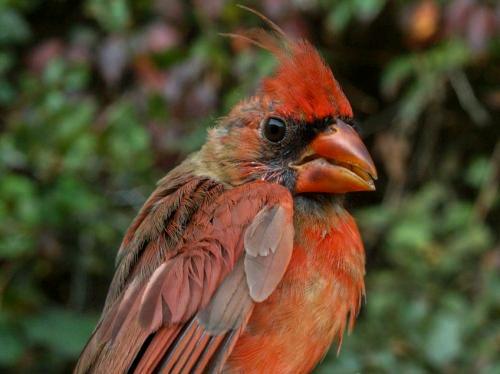
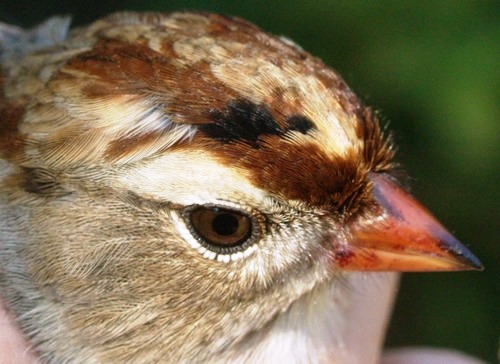 Also on the theme of moult this week, this hatch-year White-crowned Sparrow has already started to acquire some black feathers on its crown. (Photo by Simon Duval)
Also on the theme of moult this week, this hatch-year White-crowned Sparrow has already started to acquire some black feathers on its crown. (Photo by Simon Duval)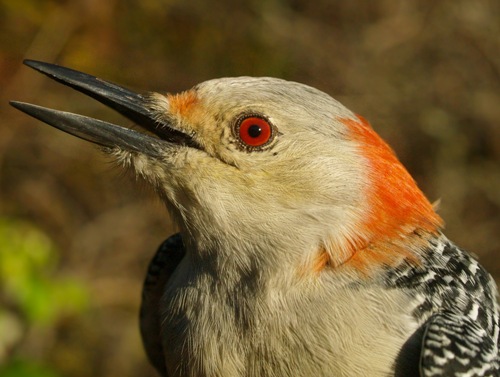 What a way to begin our final week of fall – this hatch-year female Red-bellied Woodpecker was the first of its kind ever banded at McGill Bird Observatory! (Photo by Simon Duval)
What a way to begin our final week of fall – this hatch-year female Red-bellied Woodpecker was the first of its kind ever banded at McGill Bird Observatory! (Photo by Simon Duval)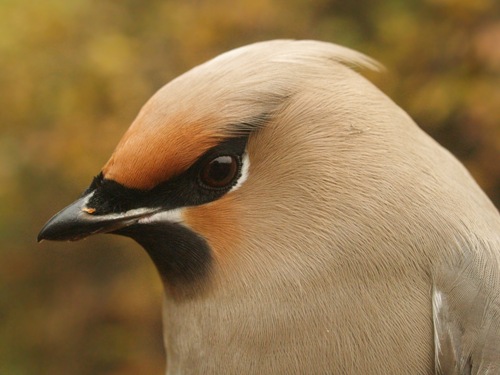 In almost any other week, this Bohemian Waxwing would have been the highlight without a doubt, since like the Red-bellied Woodpecker that stole the show a few days earlier, it was the first of its kind ever banded at MBO. And while almost a week 13 tradition at MBO, Northern Shrikes like the young one below banded on October 24 are still a rare treat, given that this was only the 13th individual banded in our 8 years. (Photos by Simon Duval)
In almost any other week, this Bohemian Waxwing would have been the highlight without a doubt, since like the Red-bellied Woodpecker that stole the show a few days earlier, it was the first of its kind ever banded at MBO. And while almost a week 13 tradition at MBO, Northern Shrikes like the young one below banded on October 24 are still a rare treat, given that this was only the 13th individual banded in our 8 years. (Photos by Simon Duval)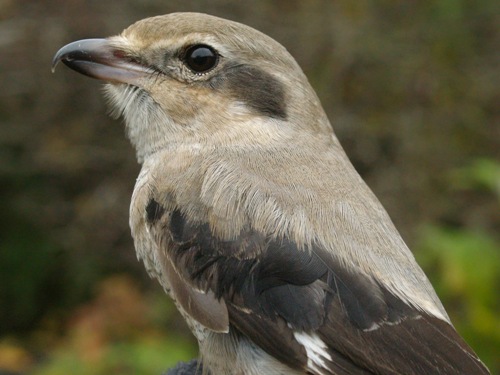
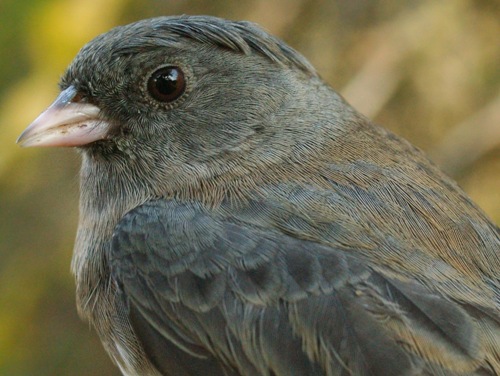 This Slate-colored Junco was the 4,000th bird banded at MBO this fall. (Photo by Simon Duval)
This Slate-colored Junco was the 4,000th bird banded at MBO this fall. (Photo by Simon Duval)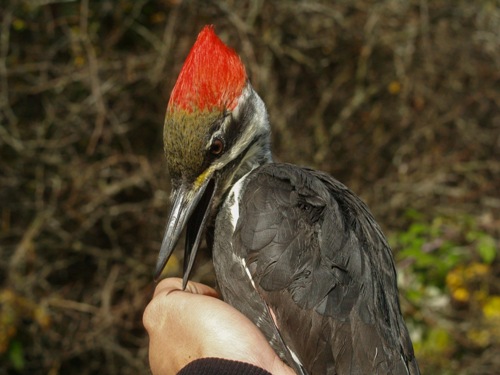 In a week full of rarities, we can’t overlook this Pileated Woodpecker – our second of the season (a record in fact!) but only our seventh in total. (Photo by Simon Duval)
In a week full of rarities, we can’t overlook this Pileated Woodpecker – our second of the season (a record in fact!) but only our seventh in total. (Photo by Simon Duval)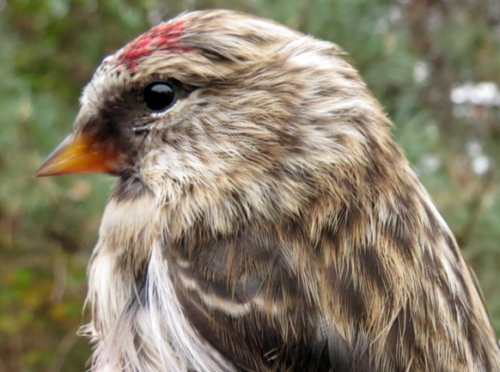 The last of this week’s unexpected species was Common Redpoll – we’ve banded 116 of them in winter, but never before any in fall … perhaps the three we had this week are an omen of an early winter headed this way? (Photo by Gay Gruner)
The last of this week’s unexpected species was Common Redpoll – we’ve banded 116 of them in winter, but never before any in fall … perhaps the three we had this week are an omen of an early winter headed this way? (Photo by Gay Gruner)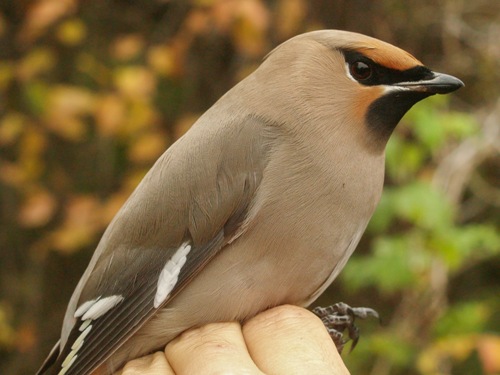 This week’s two newcomers both deserve another look. The pose above reveals the Bohemian Waxwing to be a hatch-year female (without any yellow or red on the wings), while the photo below reveals a bit more of the Red-bellied Woodpecker’s striking pattern. (Photos by Simon Duval)
This week’s two newcomers both deserve another look. The pose above reveals the Bohemian Waxwing to be a hatch-year female (without any yellow or red on the wings), while the photo below reveals a bit more of the Red-bellied Woodpecker’s striking pattern. (Photos by Simon Duval)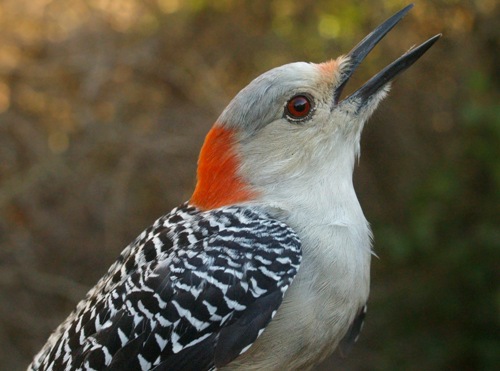
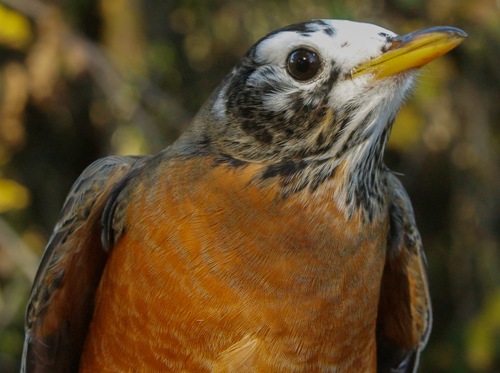 Closing out our reports for fall 2012 is this uniquely plumaged American Robin. (Photo by Simon Duval)
Closing out our reports for fall 2012 is this uniquely plumaged American Robin. (Photo by Simon Duval)